Optical Second Harmonic Generation of Low-Dimensional Semiconductor Materials
Abstract
:1. Introduction
2. Theoretical Background
2.1. Basic Concept of SHG
2.2. Experiment Method
3. State of the Art of LDM-Based SHG
3.1. 2D Materials
3.1.1. SHG in Graphene
3.1.2. SHG in Transition Metal Dichalcogenides (TMDs)

3.1.3. SHG in Group IV Monochalcogenides
3.1.4. SHG in Group III–VI
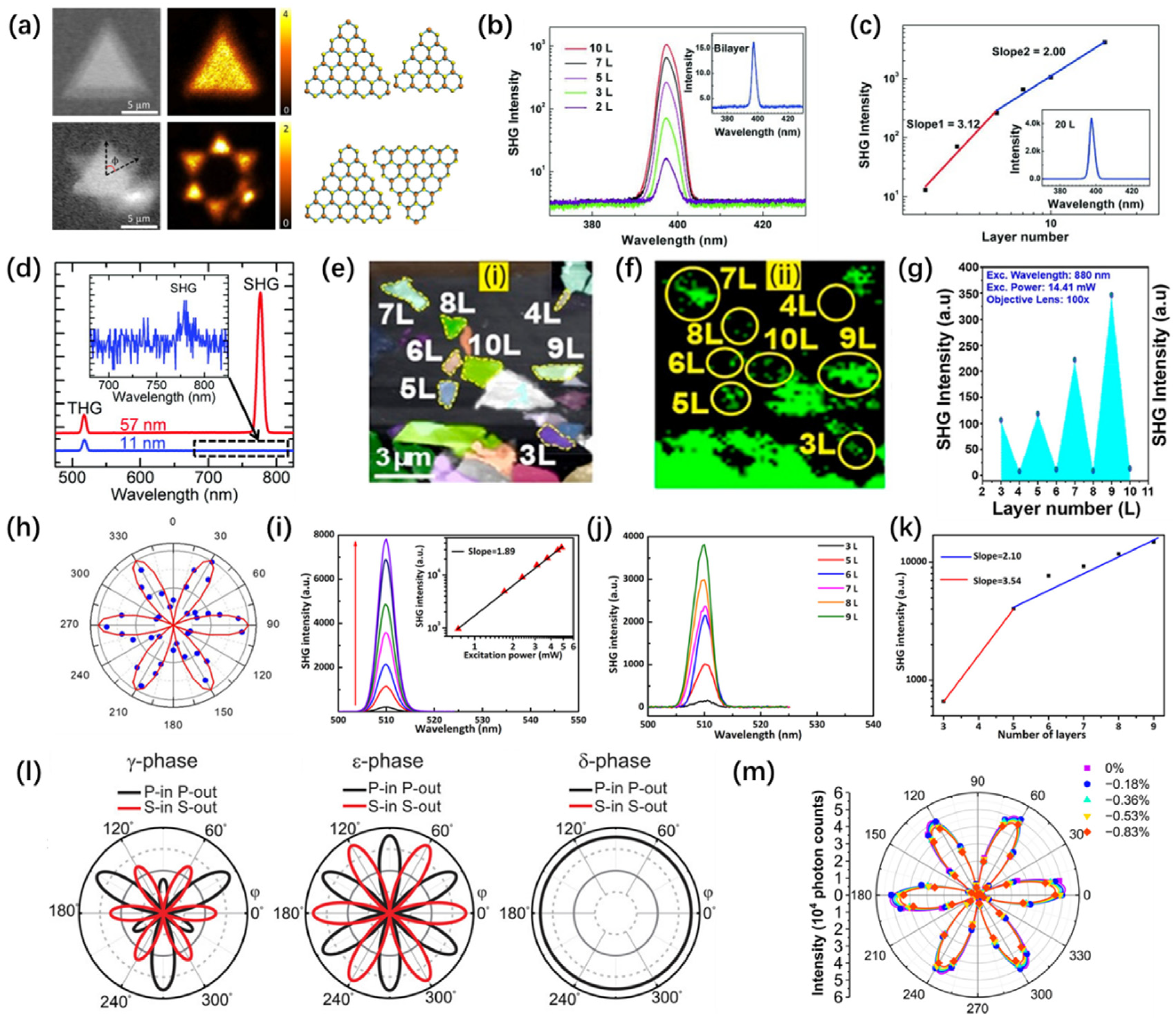
3.2. LD Halide Perovskites
3.3. Nanomaterials
4. Perspective for LDM-Based SHG
4.1. SHG Imaging
4.2. Time-Resolved SHG
5. Summary and Outlook
Author Contributions
Funding
Conflicts of Interest
References
- Franken, P.A.; Hill, A.E.; Peters, C.W.; Weinreich, G. Generation of Optical Harmonics. Phys. Rev. Lett. 1961, 7, 118–119. [Google Scholar] [CrossRef]
- Kauranen, M.; Zayats, A.V. Nonlinear plasmonics. Nat. Photonics 2012, 6, 737–748. [Google Scholar] [CrossRef]
- Wen, X.; Gong, Z.; Li, D. Nonlinear optics of two-dimensional transition metal dichalcogenides. InfoMat 2019, 1, 317–337. [Google Scholar] [CrossRef]
- Zhai, T.; Li, Y.; Xu, X.; Hu, H.; Wang, F.; Xia, F. Application of Second Harmonic Generation in Characterization of 2D Materials. J. Inorg. Mater. 2021, 36, 1022–1030. [Google Scholar]
- Panoiu, N.C.; Sha, W.E.I.; Lei, D.Y.; Li, G.C. Nonlinear optics in plasmonic nanostructures. J. Opt. 2018, 20, 083001. [Google Scholar] [CrossRef]
- Ma, H.; Liang, J.; Hong, H.; Liu, K.; Zou, D.; Wu, M.; Liu, K. Rich information on 2D materials revealed by optical second harmonic generation. Nanoscale 2020, 12, 22891–22903. [Google Scholar] [CrossRef]
- Li, J.; Hu, G.; Shi, L.; He, N.; Li, D.; Shang, Q.; Zhang, Q.; Fu, H.; Zhou, L.; Xiong, W.; et al. Full-color enhanced second harmonic generation using rainbow trapping in ultrathin hyperbolic metamaterials. Nat. Commun. 2021, 12, 6425. [Google Scholar] [CrossRef] [PubMed]
- Ngo, G.Q.; Najafidehaghani, E.; Gan, Z.; Khazaee, S.; Siems, M.P.; George, A.; Schartner, E.P.; Nolte, S.; Ebendorff-Heidepriem, H.; Pertsch, T.; et al. In-fibre second-harmonic generation with embedded two-dimensional materials. Nat. Photonics 2022, 16, 769–776. [Google Scholar] [CrossRef]
- Fiebig, M.; Pavlov, V.V.; Pisarev, R.V. Second-harmonic generation as a tool for studying electronic and magnetic structures of crystals: Review. J. Opt. Soc. Am. B 2005, 22, 96–118. [Google Scholar] [CrossRef]
- Li, Y.; Rao, Y.; Mak, K.F.; You, Y.; Wang, S.; Dean, C.R.; Heinz, T.F. Probing symmetry properties of few-layer MoS2 and h-BN by optical second-harmonic generation. Nano Lett. 2013, 13, 3329–3333. [Google Scholar] [CrossRef]
- Ju, H.; Lee, Y.; Kim, K.T.; Choi, I.H.; Roh, C.J.; Son, S.; Park, P.; Kim, J.H.; Jung, T.S.; Kim, J.H.; et al. Possible Persistence of Multiferroic Order down to Bilayer Limit of van der Waals Material NiI2. Nano Lett. 2021, 21, 5126–5132. [Google Scholar] [CrossRef] [PubMed]
- Roh, C.J.; Hamh, S.Y.; Woo, C.S.; Kim, K.E.; Yang, C.H.; Lee, J.S. Ferroelectric domain states of a tetragonal BiFeO3 thin film investigated by second harmonic generation microscopy. Nanoscale Res. Lett. 2017, 12, 353. [Google Scholar] [CrossRef] [PubMed]
- Sun, M.; Wang, G.; Yao, J. The Kurtz-Perry Powder Technique Revisited: A Study of the Effect of Reference Selection on Powder Second-Harmonic Generation Response. Molecules 2023, 28, 1116. [Google Scholar] [CrossRef] [PubMed]
- Zhao, M.; Ye, Z.; Suzuki, R.; Ye, Y.; Zhu, H.; Xiao, J.; Wang, Y.; Iwasa, Y.; Zhang, X. Atomically phase-matched second-harmonic generation in a 2D crystal. Light. Sci. Appl. 2016, 5, e16131. [Google Scholar] [CrossRef] [PubMed]
- Klein, J.; Wierzbowski, J.; Steinhoff, A.; Florian, M.; Rosner, M.; Heimbach, F.; Muller, K.; Jahnke, F.; Wehling, T.O.; Finley, J.J.; et al. Electric-Field Switchable Second-Harmonic Generation in Bilayer MoS2 by Inversion Symmetry Breaking. Nano Lett. 2017, 17, 392–398. [Google Scholar] [CrossRef] [PubMed]
- Le, C.T.; Clark, D.J.; Ullah, F.; Jang, J.I.; Senthilkumar, V.; Sim, Y.; Seong, M.-J.; Chung, K.-H.; Kim, J.W.; Park, S.; et al. Impact of Selenium Doping on Resonant Second-Harmonic Generation in Monolayer MoS2. ACS Photonics 2016, 4, 38–44. [Google Scholar] [CrossRef]
- Rakita, Y.; Bar-Elli, O.; Meirzadeh, E.; Kaslasi, H.; Peleg, Y.; Hodes, G.; Lubomirsky, I.; Oron, D.; Ehre, D.; Cahen, D. Tetragonal CH3NH3PbI3 is ferroelectric. Proc. Natl. Acad. Sci. USA 2017, 114, E5504–E5512. [Google Scholar] [CrossRef]
- Stoumpos, C.C.; Frazer, L.; Clark, D.J.; Kim, Y.S.; Rhim, S.H.; Freeman, A.J.; Ketterson, J.B.; Jang, J.I.; Kanatzidis, M.G. Hybrid germanium iodide perovskite semiconductors: Active lone pairs, structural distortions, direct and indirect energy gaps, and strong nonlinear optical properties. J. Am. Chem. Soc. 2015, 137, 6804–6819. [Google Scholar] [CrossRef]
- Han, X.; Zheng, Y.; Chai, S.; Chen, S.; Xu, J. 2D organic-inorganic hybrid perovskite materials for nonlinear optics. Nanophotonics 2020, 9, 1787–1810. [Google Scholar] [CrossRef]
- Yao, L.; Zeng, Z.; Cai, C.; Xu, P.; Gu, H.; Gao, L.; Han, J.; Zhang, X.; Wang, X.; Wang, X.; et al. Strong Second- and Third-Harmonic Generation in 1D Chiral Hybrid Bismuth Halides. J. Am. Chem. Soc. 2021, 143, 16095–16104. [Google Scholar] [CrossRef]
- Zhao, J.; Huo, H.; Zhao, Y.; Guo, Y.; Dong, M.; Fu, Y.; Zhang, J.; Gao, Z.; Kang, L. Chiral Hybrid Perovskites (R-/S-CLPEA)4Bi2I10 with Enhanced Chirality and Spin–Orbit Coupling Splitting for Strong Nonlinear Optical Circular Dichroism and Spin Selectivity Effects. Chem. Mater. 2023, 35, 4347–4354. [Google Scholar] [CrossRef]
- Capretti, A.; Pecora, E.F.; Forestiere, C.; Dal Negro, L.; Miano, G. Size-dependent second-harmonic generation from gold nanoparticles. Phys. Rev. B 2014, 89, 125414. [Google Scholar] [CrossRef]
- Finazzi, M.; Biagioni, P.; Celebrano, M.; Duò, L. Selection rules for second-harmonic generation in nanoparticles. Phys. Rev. B 2007, 76, 125414. [Google Scholar] [CrossRef]
- Pu, Y.; Hsieh, C.-L.; Grange, R.; Yang, X.; Papadopoulos, I.; Choi, J.-W.; Psaltis, D. Second harmonic nanoparticles in imaging applications. Proc. SPIE 2011, 8095, 80950E. [Google Scholar]
- Panmai, M.; Xiang, J.; Zhou, L.; Li, S.; Lan, S. Revealing Mie Resonances with Enhanced and Suppressed Second-Order Nonlinear Optical Responses in a Hexagonal-Prism-Like MoS2 Nanoparticle. Laser Photonics Rev. 2023, 17, 2300346. [Google Scholar] [CrossRef]
- Fryett, T.; Zhan, A.; Majumdar, A. Cavity nonlinear optics with layered materials. Nanophotonics 2018, 7, 355–370. [Google Scholar] [CrossRef]
- Autere, A.; Jussila, H.; Dai, Y.; Wang, Y.; Lipsanen, H.; Sun, Z. Nonlinear Optics with 2D Layered Materials. Adv. Mater. 2018, 30, e1705963. [Google Scholar] [CrossRef]
- Huang, W.; Xiao, Y.; Xia, F.; Chen, X.; Zhai, T. Second Harmonic Generation Control in 2D Layered Materials: Status and Outlook. Adv. Funct. Mater. 2024, 2310726. [Google Scholar] [CrossRef]
- Wang, Y.; Xiao, J.; Yang, S.; Wang, Y.; Zhang, X. Second harmonic generation spectroscopy on two-dimensional materials [Invited]. Opt. Mater. Express 2019, 9, 1136–1149. [Google Scholar] [CrossRef]
- Zhang, J.; Zhao, W.; Yu, P.; Yang, G.; Liu, Z. Second harmonic generation in 2D layered materials. 2D Mater. 2020, 7, 042002. [Google Scholar] [CrossRef]
- Boyd, R.W.; Masters, B.R. Nonlinear Optics. J. Biomed. Opt. 2009, 14, 029902. [Google Scholar] [CrossRef]
- Hsu, W.T.; Zhao, Z.A.; Li, L.J.; Chen, C.H.; Chiu, M.H.; Chang, P.S.; Chou, Y.C.; Chang, W.H. Second harmonic generation from artificially stacked transition metal dichalcogenide twisted bilayers. ACS Nano 2014, 8, 2951–2958. [Google Scholar] [CrossRef]
- Seyler, K.L.; Schaibley, J.R.; Gong, P.; Rivera, P.; Jones, A.M.; Wu, S.; Yan, J.; Mandrus, D.G.; Yao, W.; Xu, X. Electrical control of second-harmonic generation in a WSe2 monolayer transistor. Nat. Nanotechnol. 2015, 10, 407–411. [Google Scholar] [CrossRef]
- Kumar, N.; Najmaei, S.; Cui, Q.; Ceballos, F.; Ajayan, P.M.; Lou, J.; Zhao, H. Second harmonic microscopy of monolayer MoS2. Phys. Rev. B 2013, 87, 161403. [Google Scholar] [CrossRef]
- Shinde, S.M.; Dhakal, K.P.; Chen, X.; Yun, W.S.; Lee, J.; Kim, H.; Ahn, J.-H. Stacking-controllable interlayer coupling and symmetric configuration of multilayered MoS2. NPG Asia Mater. 2018, 10, e468. [Google Scholar] [CrossRef]
- Hora, H. Y.R. Shen, The Principles of Nonlinear Optics, John Wiley & Sons, New York, 1984, 576 pages. Laser Part. Beams 2009, 4, 318–319. [Google Scholar]
- Wang, G.; Marie, X.; Gerber, I.; Amand, T.; Lagarde, D.; Bouet, L.; Vidal, M.; Balocchi, A.; Urbaszek, B. Giant enhancement of the optical second-harmonic emission of WSe2 monolayers by laser excitation at exciton resonances. Phys. Rev. Lett. 2015, 114, 097403. [Google Scholar] [CrossRef]
- Trolle, M.L.; Seifert, G.; Pedersen, T.G. Theory of excitonic second-harmonic generation in monolayer MoS2. Phys. Rev. B 2014, 89, 235410. [Google Scholar] [CrossRef]
- Liu, H.; Li, Y.; You, Y.S.; Ghimire, S.; Heinz, T.F.; Reis, D.A. High-harmonic generation from an atomically thin semiconductor. Nat. Phys. 2016, 13, 262–265. [Google Scholar] [CrossRef]
- Jia, L.; Wu, J.; Zhang, Y.; Qu, Y.; Jia, B.; Chen, Z.; Moss, D.J. Fabrication Technologies for the On-Chip Integration of 2D Materials. Small Methods 2022, 6, e2101435. [Google Scholar] [CrossRef]
- Janisch, C.; Wang, Y.; Ma, D.; Mehta, N.; Elias, A.L.; Perea-Lopez, N.; Terrones, M.; Crespi, V.; Liu, Z. Extraordinary Second Harmonic Generation in tungsten disulfide monolayers. Sci. Rep. 2014, 4, 5530. [Google Scholar] [CrossRef]
- Taghizadeh, A.; Pedersen, T.G. Nonlinear optical selection rules of excitons in monolayer transition metal dichalcogenides. Phys. Rev. B 2019, 99, 235433. [Google Scholar] [CrossRef]
- You, J.W.; Bongu, S.R.; Bao, Q.; Panoiu, N.C. Nonlinear optical properties and applications of 2D materials: Theoretical and experimental aspects. Nanophotonics 2018, 8, 63–97. [Google Scholar] [CrossRef]
- Frizyuk, K.; Volkovskaya, I.; Smirnova, D.; Poddubny, A.; Petrov, M. Second-harmonic generation in Mie-resonant dielectric nanoparticles made of noncentrosymmetric materials. Phys. Rev. B 2019, 99, 075425. [Google Scholar] [CrossRef]
- Vianna, P.G.; Almeida, A.D.S.; Gerosa, R.M.; Bahamon, D.A.; de Matos, C.J.S. Second-harmonic generation enhancement in monolayer transition-metal dichalcogenides by using an epsilon-near-zero substrate. Nanoscale Adv. 2021, 3, 272–278. [Google Scholar] [CrossRef]
- Shree, S.; Lagarde, D.; Lombez, L.; Robert, C.; Balocchi, A.; Watanabe, K.; Taniguchi, T.; Marie, X.; Gerber, I.C.; Glazov, M.M.; et al. Interlayer exciton mediated second harmonic generation in bilayer MoS2. Nat. Commun. 2021, 12, 6894. [Google Scholar] [CrossRef]
- Zimmermann, J.E.; Kim, Y.D.; Hone, J.C.; Hofer, U.; Mette, G. Directional ultrafast charge transfer in a WSe2/MoSe2 heterostructure selectively probed by time-resolved SHG imaging microscopy. Nanoscale Horiz. 2020, 5, 1603–1609. [Google Scholar] [CrossRef]
- Zhou, Z.; Shen, T.; Wang, P.; Guo, Q.; Wang, Q.; Ma, C.; Xin, K.; Zhao, K.; Yu, Y.; Qin, B.; et al. Low symmetric sub-wavelength array enhanced lensless polarization-sensitivity photodetector of germanium selenium. Sci. Bull. 2023, 68, 173–179. [Google Scholar] [CrossRef]
- Xie, Y.; Yu, H.; Wei, J.; He, Q.; Yu, H.; Zhang, H. Strong, anisotropic, layer-independent second harmonic generation in multilayer SnS film. Opt. Express 2023, 31, 9779–9789. [Google Scholar] [CrossRef]
- Mao, N.; Luo, Y.; Chiu, M.H.; Shi, C.; Ji, X.; Pieshkov, T.S.; Lin, Y.; Tang, H.L.; Akey, A.J.; Gardener, J.A.; et al. Giant Nonlinear Optical Response via Coherent Stacking of In-Plane Ferroelectric Layers. Adv. Mater. 2023, 35, e2210894. [Google Scholar] [CrossRef]
- Zhang, M.; Han, N.; Zhang, J.; Wang, J.; Chen, X.; Zhao, J.; Gan, X. Emergent second-harmonic generation in van der Waals heterostructure of bilayer MoS2 and monolayer graphene. Sci. Adv. 2023, 9, eadf4571. [Google Scholar] [CrossRef]
- Paradisanos, I.; Raven, A.M.S.; Amand, T.; Robert, C.; Renucci, P.; Watanabe, K.; Taniguchi, T.; Gerber, I.C.; Marie, X.; Urbaszek, B. Second harmonic generation control in twisted bilayers of transition metal dichalcogenides. Phys. Rev. B 2022, 105, 115420. [Google Scholar] [CrossRef]
- Zhang, X.; Zhou, J.; Li, S.Q.; Wang, Y.; Zhang, S.; Liu, Y.; Gao, J.; Zhao, J.; Wang, W.; Yu, R.; et al. Enhanced Valley Polarization of Bilayer MoSe2 with Variable Stacking Order and Interlayer Coupling. J. Phys. Chem. Lett. 2021, 12, 5879–5888. [Google Scholar] [CrossRef]
- Zhou, W.; Hua, J.; Liu, N.; Ding, J.; Xiang, H.; Zhu, W.; Xu, S. Inversion symmetry-broken tetralayer graphene probed by second harmonic generation. arXiv 2023, arXiv:2311.16797. [Google Scholar]
- Lu, K.; Luo, M.; Gao, W.; Wang, Q.J.; Sun, H.; Nam, D. Strong second-harmonic generation by sublattice polarization in non-uniformly strained monolayer graphene. Nat. Commun. 2023, 14, 2580. [Google Scholar] [CrossRef]
- Maragkakis, G.M.; Psilodimitrakopoulos, S.; Mouchliadis, L.; Sarkar, A.S.; Lemonis, A.; Kioseoglou, G.; Stratakis, E. Nonlinear Optical Imaging of In-Plane Anisotropy in Two-Dimensional SnS. Adv. Opt. Mater. 2022, 10, 2270038. [Google Scholar] [CrossRef]
- Zhu, M.; Zhong, M.; Guo, X.; Wang, Y.; Chen, Z.; Huang, H.; He, J.; Su, C.; Loh, K.P. Efficient and Anisotropic Second Harmonic Generation in Few-Layer SnS Film. Adv. Opt. Mater. 2021, 9, 2101200. [Google Scholar] [CrossRef]
- Fan, X.; Ji, Z.; Fei, R.; Zheng, W.; Liu, W.; Zhu, X.; Chen, S.; Yang, L.; Liu, H.; Pan, A.; et al. Mechanism of Extreme Optical Nonlinearities in Spiral WS2 above the Bandgap. Nano Lett. 2020, 20, 2667–2673. [Google Scholar] [CrossRef]
- Mokim, M.; Card, A.; Ganikhanov, F. Nonlinear optical susceptibility of atomically thin WX2 crystals. Opt. Mater. 2019, 88, 30–38. [Google Scholar] [CrossRef]
- Shradha, S.; Abtahi, F.; Gan, Z.; Knopf, H.; Fedotova, A.; Löchner, F.J.F.; George, A.; Pertsch, T.; Turchanin, A.; Eilenberger, F. Towards Double Resonant Cavity Enhanced Second Harmonic Generation in Monolayer MoS2. Adv. Opt. Mater. 2023, 12, 2300907. [Google Scholar] [CrossRef]
- Mennel, L.; Paur, M.; Mueller, T. Second harmonic generation in strained transition metal dichalcogenide monolayers: MoS2, MoSe2, WS2, and WSe2. APL Photonics 2019, 4, 034404. [Google Scholar] [CrossRef]
- Nappa, J.; Revillod, G.; Russier-Antoine, I.; Benichou, E.; Jonin, C.; Brevet, P.F. Electric dipole origin of the second harmonic generation of small metallic particles. Phys. Rev. B 2005, 71, 165407. [Google Scholar] [CrossRef]
- Singh, A.K.; Senapati, D.; Neely, A.; Kolawole, G.; Hawker, C.; Ray, P.C. Nonlinear optical properties of triangular silver nanomaterials. Chem. Phys. Lett. 2009, 481, 94–98. [Google Scholar] [CrossRef]
- Zielinski, M.; Oron, D.; Chauvat, D.; Zyss, J. Second-harmonic generation from a single core/shell quantum dot. Small 2009, 5, 2835–2840. [Google Scholar] [CrossRef] [PubMed]
- Bonacina, L.; Mugnier, Y.; Courvoisier, F.; Le Dantec, R.; Extermann, J.; Lambert, Y.; Boutou, V.; Galez, C.; Wolf, J.P. Polar Fe(IO3)3 nanocrystals as local probes for nonlinear microscopy. Appl. Phys. B 2007, 87, 399–403. [Google Scholar] [CrossRef]
- Hsieh, C.-L.; Grange, R.; Pu, Y.; Psaltis, D. Three-dimensional harmonic holographic microcopy using nanoparticles as probes for cell imaging. Opt. Express 2009, 17, 2880–2891. [Google Scholar] [CrossRef] [PubMed]
- Djurisic, A.B.; Leung, Y.H. Optical properties of ZnO nanostructures. Small 2006, 2, 944–961. [Google Scholar] [CrossRef] [PubMed]
- Jacobsohn, M.; Banin, U. Size dependence of second harmonic generation in CdSe nanocrystal quantum dots. J. Phys. Chem. B 2000, 104, 1–5. [Google Scholar] [CrossRef]
- Canfield, B.K.; Husu, H.; Laukkanen, J.; Bai, B.; Kuittinen, M.; Turunen, J.; Kauranen, M. Local Field Asymmetry Drives Second-Harmonic Generation in Noncentrosymmetric Nanodimers. Nano Lett. 2007, 7, 1251–1255. [Google Scholar] [CrossRef]
- Vidal, X.; Fedyanin, A.; Molinos-Gómez, A.; Rao, S.; Martorell, J.; Petrov, D. Nonlinear optical response from single spheres coated by a nonlinear monolayer. Opt. Lett. 2008, 33, 3. [Google Scholar] [CrossRef]
- Keerthi, A.; Geim, A.K.; Janardanan, A.; Rooney, A.P.; Esfandiar, A.; Hu, S.; Dar, S.A.; Grigorieva, I.V.; Haigh, S.J.; Wang, F.C.; et al. Ballistic molecular transport through two-dimensional channels. Nature 2018, 558, 420–424. [Google Scholar] [CrossRef]
- Zhou, R.; Guo, T.; Huang, L.; Ullah, K. Engineering the harmonic generation in graphene. Mater. Today Phys. 2022, 23, 100649. [Google Scholar] [CrossRef]
- Lee, C.; Wei, X.; Kysar, J.W.; Hone, J. Measurement of the elastic properties and intrinsic strength of monolayer graphene. Science 2008, 321, 385–388. [Google Scholar] [CrossRef]
- Morozov, S.V.; Novoselov, K.S.; Katsnelson, M.I.; Schedin, F.; Elias, D.C.; Jaszczak, J.A.; Geim, A.K. Giant intrinsic carrier mobilities in graphene and its bilayer. Phys. Rev. Lett. 2008, 100, 016602. [Google Scholar] [CrossRef]
- Mak, K.F.; Sfeir, M.Y.; Wu, Y.; Lui, C.H.; Misewich, J.A.; Heinz, T.F. Measurement of the optical conductivity of graphene. Phys. Rev. Lett. 2008, 101, 196405. [Google Scholar] [CrossRef]
- Xia, F.; Mueller, T.; Lin, Y.M.; Valdes-Garcia, A.; Avouris, P. Ultrafast graphene photodetector. Nat. Nanotechnol. 2009, 4, 839–843. [Google Scholar] [CrossRef]
- Ju, L.; Geng, B.; Horng, J.; Girit, C.; Martin, M.; Hao, Z.; Bechtel, H.A.; Liang, X.; Zettl, A.; Shen, Y.R.; et al. Graphene plasmonics for tunable terahertz metamaterials. Nat. Nanotechnol. 2011, 6, 630–634. [Google Scholar]
- Liu, M.; Yin, X.; Ulin-Avila, E.; Geng, B.; Zentgraf, T.; Ju, L.; Wang, F.; Zhang, X. A graphene-based broadband optical modulator. Nature 2011, 474, 64–67. [Google Scholar] [CrossRef]
- Zhang, Y.; Huang, D.; Shan, Y.; Jiang, T.; Zhang, Z.; Liu, K.; Shi, L.; Cheng, J.; Sipe, J.E.; Liu, W.T.; et al. Doping-Induced Second-Harmonic Generation in Centrosymmetric Graphene from Quadrupole Response. Phys. Rev. Lett. 2019, 122, 047401. [Google Scholar] [CrossRef]
- Cheng, J.L.; Vermeulen, N.; Sipe, J.E. DC current induced second order optical nonlinearity in graphene. Opt. Express 2014, 22, 15868–15876. [Google Scholar]
- An, Y.Q.; Rowe, J.E.; Dougherty, D.B.; Lee, J.U.; Diebold, A.C. Optical second-harmonic generation induced by electric current in graphene on Si and SiC substrates. Phys. Rev. B 2014, 89, 115310. [Google Scholar] [CrossRef]
- Zhang, M.; Han, N.; Wang, J.; Zhang, Z.; Liu, K.; Sun, Z.; Zhao, J.; Gan, X. Strong Second Harmonic Generation from Bilayer Graphene with Symmetry Breaking by Redox-Governed Charge Doping. Nano Lett. 2022, 22, 4287–4293. [Google Scholar] [CrossRef]
- Shan, Y.; Li, Y.; Huang, D.; Tong, Q.; Yao, W.; Liu, W.T.; Wu, S. Stacking symmetry governed second harmonic generation in graphene trilayers. Sci. Adv. 2018, 4, eaat0074. [Google Scholar] [CrossRef]
- Yang, F.; Song, W.; Meng, F.; Luo, F.; Lou, S.; Lin, S.; Gong, Z.; Cao, J.; Barnard, E.S.; Chan, E.; et al. Tunable Second Harmonic Generation in Twisted Bilayer Graphene. Matter 2020, 3, 1361–1376. [Google Scholar] [CrossRef]
- Brun, S.J.; Pedersen, T.G. Intense and tunable second-harmonic generation in biased bilayer graphene. Phys. Rev. B 2015, 91, 205405. [Google Scholar] [CrossRef]
- Golub, L.E.; Tarasenko, S.A. Valley polarization induced second harmonic generation in graphene. Phys. Rev. B 2014, 90, 201402. [Google Scholar]
- Wu, C.; Shang, N.; Zhao, Z.; Zhang, Z.; Liang, J.; Liu, C.; Zuo, Y.; Ding, M.; Wang, J.; Hong, H.; et al. Modulation of the second-harmonic generation in MoS2 by graphene covering. Chin. Phys. B 2021, 30, 027803. [Google Scholar] [CrossRef]
- Wang, Q.H.; Kalantar-Zadeh, K.; Kis, A.; Coleman, J.N.; Strano, M.S. Electronics and optoelectronics of two-dimensional transition metal dichalcogenides. Nat. Nanotechnol. 2012, 7, 699–712. [Google Scholar] [CrossRef]
- Chou, S.S.; Sai, N.; Lu, P.; Coker, E.N.; Liu, S.; Artyushkova, K.; Luk, T.S.; Kaehr, B.; Brinker, C.J. Understanding catalysis in a multiphasic two-dimensional transition metal dichalcogenide. Nat. Commun. 2015, 6, 8311. [Google Scholar] [CrossRef]
- Chia, X.; Ambrosi, A.; Sofer, Z.; Luxa, J.; Pumera, M. Catalytic and charge transfer properties of transition metal dichalcogenides arising from electrochemical pretreatment. ACS Nano 2015, 9, 5164–5179. [Google Scholar] [CrossRef]
- Kalantar-zadeh, K.; Ou, J.Z.; Daeneke, T.; Strano, M.S.; Pumera, M.; Gras, S.L. Two-Dimensional Transition Metal Dichalcogenides in Biosystems. Adv. Funct. Mater. 2015, 25, 5086–5099. [Google Scholar] [CrossRef]
- Sarkar, D.; Xie, X.; Kang, J.; Zhang, H.; Liu, W.; Navarrete, J.; Moskovits, M.; Banerjee, K. Functionalization of transition metal dichalcogenides with metallic nanoparticles: Implications for doping and gas-sensing. Nano Lett. 2015, 15, 2852–2862. [Google Scholar] [CrossRef]
- Cao, X.; Tan, C.; Zhang, X.; Zhao, W.; Zhang, H. Solution-Processed Two-Dimensional Metal Dichalcogenide-Based Nanomaterials for Energy Storage and Conversion. Adv. Mater. 2016, 28, 6167–6196. [Google Scholar] [CrossRef]
- Manzeli, S.; Ovchinnikov, D.; Pasquier, D.; Yazyev, O.V.; Kis, A. 2D transition metal dichalcogenides. Nat. Rev. Mater. 2017, 2, 17033. [Google Scholar] [CrossRef]
- Toh, R.J.; Sofer, Z.; Luxa, J.; Sedmidubsky, D.; Pumera, M. 3R phase of MoS2 and WS2 outperforms the corresponding 2H phase for hydrogen evolution. Chem. Commun. 2017, 53, 3054–3057. [Google Scholar] [CrossRef]
- Kang, M.; Kim, B.; Ryu, S.H.; Jung, S.W.; Kim, J.; Moreschini, L.; Jozwiak, C.; Rotenberg, E.; Bostwick, A.; Kim, K.S. Universal Mechanism of Band-Gap Engineering in Transition-Metal Dichalcogenides. Nano Lett. 2017, 17, 1610–1615. [Google Scholar] [CrossRef]
- Samy, O.; Zeng, S.; Birowosuto, M.D.; El Moutaouakil, A. A Review on MoS2 Properties, Synthesis, Sensing Applications and Challenges. Crystals 2021, 11, 355. [Google Scholar] [CrossRef]
- Khan, A.R.; Zhang, L.; Ishfaq, K.; Ikram, A.; Yildrim, T.; Liu, B.; Rahman, S.; Lu, Y. Optical Harmonic Generation in 2D Materials. Adv. Funct. Mater. 2021, 32, 2105259. [Google Scholar] [CrossRef]
- Zeng, Z.; Sun, X.; Zhang, D.; Zheng, W.; Fan, X.; He, M.; Xu, T.; Sun, L.; Wang, X.; Pan, A. Controlled Vapor Growth and Nonlinear Optical Applications of Large-Area 3R Phase WS2 and WSe2 Atomic Layers. Adv. Funct. Mater. 2019, 29, 1806874. [Google Scholar] [CrossRef]
- Khan, A.R.; Liu, B.; Zhang, L.; Zhu, Y.; He, X.; Zhang, L.; Lü, T.; Lu, Y. Extraordinary Temperature Dependent Second Harmonic Generation in Atomically Thin Layers of Transition-Metal Dichalcogenides. Adv. Opt. Mater. 2020, 8, 2000441. [Google Scholar] [CrossRef]
- Malard, L.M.; Alencar, T.V.; Barboza, A.P.M.; Mak, K.F.; de Paula, A.M. Observation of intense second harmonic generation from MoS2 atomic crystals. Phys. Rev. B 2013, 87, 201401. [Google Scholar] [CrossRef]
- Clark, D.J.; Senthilkumar, V.; Le, C.T.; Weerawarne, D.L.; Shim, B.; Jang, J.I.; Shim, J.H.; Cho, J.; Sim, Y.; Seong, M.J.; et al. Strong optical nonlinearity of CVD-grown MoS2 monolayer as probed by wavelength-dependent second-harmonic generation. Phys. Rev. B 2014, 90, 121409. [Google Scholar] [CrossRef]
- Karvonen, L.; Saynatjoki, A.; Huttunen, M.J.; Autere, A.; Amirsolaimani, B.; Li, S.; Norwood, R.A.; Peyghambarian, N.; Lipsanen, H.; Eda, G.; et al. Rapid visualization of grain boundaries in monolayer MoS2 by multiphoton microscopy. Nat. Commun. 2017, 8, 15714. [Google Scholar] [CrossRef]
- Fan, X.; Jiang, Y.; Zhuang, X.; Liu, H.; Xu, T.; Zheng, W.; Fan, P.; Li, H.; Wu, X.; Zhu, X.; et al. Broken Symmetry Induced Strong Nonlinear Optical Effects in Spiral WS2 Nanosheets. ACS Nano 2017, 11, 4892–4898. [Google Scholar] [CrossRef]
- Forcherio, G.T.; Riporto, J.; Dunklin, J.R.; Mugnier, Y.; Dantec, R.L.; Bonacina, L.; Roper, D.K. Nonlinear optical susceptibility of two-dimensional WS2 measured by hyper Rayleigh scattering. Opt. Lett. 2017, 42, 5018–5021. [Google Scholar] [CrossRef]
- Le, C.T.; Clark, D.J.; Ullah, F.; Senthilkumar, V.; Jang, J.I.; Sim, Y.; Seong, M.J.; Chung, K.H.; Park, H.; Kim, Y.S. Nonlinear optical characteristics of monolayer MoSe2. Ann. Phys. 2016, 528, 551–559. [Google Scholar] [CrossRef]
- Chen, H.; Corboliou, V.; Solntsev, A.S.; Choi, D.Y.; Vincenti, M.A.; de Ceglia, D.; de Angelis, C.; Lu, Y.; Neshev, D.N. Enhanced second-harmonic generation from two-dimensional MoSe2 on a silicon waveguide. Light. Sci. Appl. 2017, 6, e17060. [Google Scholar] [CrossRef]
- Rosa, H.G.; Ho, Y.W.; Verzhbitskiy, I.; Rodrigues, M.; Taniguchi, T.; Watanabe, K.; Eda, G.; Pereira, V.M.; Gomes, J.C.V. Characterization of the second- and third-harmonic optical susceptibilities of atomically thin tungsten diselenide. Sci. Rep. 2018, 8, 10035. [Google Scholar] [CrossRef]
- Beams, R.; Cancado, L.G.; Krylyuk, S.; Kalish, I.; Kalanyan, B.; Singh, A.K.; Choudhary, K.; Bruma, A.; Vora, P.M.; Tavazza, F.; et al. Characterization of Few-Layer 1T’ MoTe2 by Polarization-Resolved Second Harmonic Generation and Raman Scattering. ACS Nano 2016, 10, 9626–9636. [Google Scholar] [CrossRef]
- Qian, Q.; Zu, R.; Ji, Q.; Jung, G.S.; Zhang, K.; Zhang, Y.; Buehler, M.J.; Kong, J.; Gopalan, V.; Huang, S. Chirality-Dependent Second Harmonic Generation of MoS2 Nanoscroll with Enhanced Efficiency. ACS Nano 2020, 14, 13333–13342. [Google Scholar] [CrossRef] [PubMed]
- Taghinejad, H.; Eftekhar, A.A.; Adibi, A. Lateral and vertical heterostructures in two-dimensional transition-metal dichalcogenides [Invited]. Opt. Mater. Express 2019, 9, 1590–1607. [Google Scholar] [CrossRef]
- Mahjouri-Samani, M.; Lin, M.W.; Wang, K.; Lupini, A.R.; Lee, J.; Basile, L.; Boulesbaa, A.; Rouleau, C.M.; Puretzky, A.A.; Ivanov, I.N.; et al. Patterned arrays of lateral heterojunctions within monolayer two-dimensional semiconductors. Nat. Commun. 2015, 6, 7749. [Google Scholar] [CrossRef]
- Taghinejad, H.; Rehn, D.A.; Muccianti, C.; Eftekhar, A.A.; Tian, M.; Fan, T.; Zhang, X.; Meng, Y.; Chen, Y.; Nguyen, T.V.; et al. Defect-Mediated Alloying of Monolayer Transition-Metal Dichalcogenides. ACS Nano 2018, 12, 12795–12804. [Google Scholar] [CrossRef]
- Li, D.; Wei, C.; Song, J.; Huang, X.; Wang, F.; Liu, K.; Xiong, W.; Hong, X.; Cui, B.; Feng, A.; et al. Anisotropic Enhancement of Second-Harmonic Generation in Monolayer and Bilayer MoS2 by Integrating with TiO2 Nanowires. Nano Lett. 2019, 19, 4195–4204. [Google Scholar] [CrossRef]
- He, C.; Wu, R.; Qi, M.; Huang, Y.; Zhou, Y.; Zhang, S.; Zhao, Q.; Xu, X. Dispersion Property and Evolution of Second Harmonic Generation Pattern in Type-I and Type-II van der Waals Heterostructures. ACS Appl. Mater. Interfaces 2021, 13, 27334–27342. [Google Scholar] [CrossRef]
- Zheng, X.; Wei, Y.; Zhang, X.; Wei, Z.; Luo, W.; Guo, X.; Liu, J.; Peng, G.; Cai, W.; Huang, H.; et al. Symmetry Engineering Induced In-Plane Polarization in MoS2 through Van der Waals Interlayer Coupling. Adv. Funct. Mater. 2022, 32, 2202658. [Google Scholar] [CrossRef]
- Mehboudi, M.; Dorio, A.M.; Zhu, W.; van der Zande, A.; Churchill, H.O.; Pacheco-Sanjuan, A.A.; Harriss, E.O.; Kumar, P.; Barraza-Lopez, S. Two-Dimensional Disorder in Black Phosphorus and Monochalcogenide Monolayers. Nano Lett. 2016, 16, 1704–1712. [Google Scholar] [CrossRef]
- Wu, M.; Zeng, X.C. Intrinsic Ferroelasticity and/or Multiferroicity in Two-Dimensional Phosphorene and Phosphorene Analogues. Nano Lett. 2016, 16, 3236–3241. [Google Scholar] [CrossRef]
- Wang, H.; Qian, X. Two-dimensional multiferroics in monolayer group IV monochalcogenides. 2D Mater. 2017, 4, 015042. [Google Scholar] [CrossRef]
- Rangel, T.; Fregoso, B.M.; Mendoza, B.S.; Morimoto, T.; Moore, J.E.; Neaton, J.B. Large Bulk Photovoltaic Effect and Spontaneous Polarization of Single-Layer Monochalcogenides. Phys. Rev. Lett. 2017, 119, 067402. [Google Scholar] [CrossRef]
- Cook, A.M.; Fregoso, B.M.; de Juan, F.; Coh, S.; Moore, J.E. Design principles for shift current photovoltaics. Nat. Commun. 2017, 8, 14176. [Google Scholar] [CrossRef]
- Fregoso, B.M.; Morimoto, T.; Moore, J.E. Quantitative relationship between polarization differences and the zone-averaged shift photocurrent. Phys. Rev. B 2017, 96, 075421. [Google Scholar] [CrossRef]
- Tritsaris, G.A.; Malone, B.D.; Kaxiras, E. Optoelectronic properties of single-layer, double-layer, and bulk tin sulfide: A theoretical study. J. Appl. Phys. 2013, 113, 233507. [Google Scholar] [CrossRef]
- Mukherjee, B.; Cai, Y.; Tan, H.R.; Feng, Y.P.; Tok, E.S.; Sow, C.H. NIR Schottky photodetectors based on individual single-crystalline GeSe nanosheet. ACS Appl. Mater. Interfaces 2013, 5, 9594–9604. [Google Scholar] [CrossRef]
- Guo, R.; Wang, X.; Kuang, Y.; Huang, B. First-principles study of anisotropic thermoelectric transport properties of IV–VI semiconductor compounds SnSe and SnS. Phys. Rev. B 2015, 92, 115202. [Google Scholar] [CrossRef]
- Medrano Sandonas, L.; Teich, D.; Gutierrez, R.; Lorenz, T.; Pecchia, A.; Seifert, G.; Cuniberti, G. Anisotropic Thermoelectric Response in Two-Dimensional Puckered Structures. J. Phys. Chem. C 2016, 120, 18841–18849. [Google Scholar] [CrossRef]
- Karmakar, S.; Chowdhury, C.; Datta, A. Two-Dimensional Group IV Monochalcogenides: Anode Materials for Li-Ion Batteries. J. Phys. Chem. C 2016, 120, 14522–14530. [Google Scholar] [CrossRef]
- Nan, F.; Xie, F.-M.; Liang, S.; Ma, L.; Yang, D.-J.; Liu, X.-L.; Wang, J.-H.; Cheng, Z.-Q.; Yu, X.-F.; Zhou, L.; et al. Growth of metal–semiconductor core–multishell nanorods with optimized field confinement and nonlinear enhancement. Nanoscale 2016, 8, 11969–11975. [Google Scholar] [CrossRef]
- Wang, H.; Qian, X. Giant Optical Second Harmonic Generation in Two-Dimensional Multiferroics. Nano Lett. 2017, 17, 5027–5034. [Google Scholar] [CrossRef]
- Raj Panday, S.; Fregoso, B.M. Strong second harmonic generation in two-dimensional ferroelectric IV-monochalcogenides. J. Phys. Condens. Matter 2017, 29, 43 LT01. [Google Scholar] [CrossRef]
- Higashitarumizu, N.; Kawamoto, H.; Lee, C.J.; Lin, B.H.; Chu, F.H.; Yonemori, I.; Nishimura, T.; Wakabayashi, K.; Chang, W.H.; Nagashio, K. Purely in-plane ferroelectricity in monolayer SnS at room temperature. Nat. Commun. 2020, 11, 2428. [Google Scholar] [CrossRef]
- Yang, Z.; Hao, J. Recent Progress in 2D Layered III–VI Semiconductors and their Heterostructures for Optoelectronic Device Applications. Adv. Mater. Technol. 2019, 4, 1900108. [Google Scholar] [CrossRef]
- Hao, Q.; Yi, H.; Su, H.; Wei, B.; Wang, Z.; Lao, Z.; Chai, Y.; Wang, Z.; Jin, C.; Dai, J.; et al. Phase Identification and Strong Second Harmonic Generation in Pure epsilon-InSe and Its Alloys. Nano Lett. 2019, 19, 2634–2640. [Google Scholar] [CrossRef]
- Tang, Y.; Mandal, K.C.; McGuire, J.A.; Lai, C.W. Layer- and frequency-dependent second harmonic generation in reflection from GaSe atomic crystals. Phys. Rev. B 2016, 94, 125302. [Google Scholar] [CrossRef]
- Ma, Q.; Ge, S.L.; Li, M.X.; Jia, Q.; Wen, C.L. GaSe saturable absorber for mode-locked Yb-doped fiber laser at 1.04 µm. Infrared Phys. Technol. 2020, 105, 103251. [Google Scholar] [CrossRef]
- Li, Y.; Zhao, X.; Zhang, H.; Li, M. GaSe saturable absorber for mode-locked Er-doped fiber laser. Infrared Phys. Technol. 2019, 96, 325–329. [Google Scholar] [CrossRef]
- Liu, X.; Wang, G.; Zhu, M.; Han, K.; Zhang, W.; Zhang, H. Traditional soliton erbium-doped fiber laser with InSe as saturable absorber. Front. Inf. Technol. Electron. Eng. 2021, 22, 325–333. [Google Scholar] [CrossRef]
- Liu, F.; Shimotani, H.; Shang, H.; Kanagasekaran, T.; Zolyomi, V.; Drummond, N.; Fal’ko, V.I.; Tanigaki, K. High-sensitivity photodetectors based on multilayer GaTe flakes. ACS Nano 2014, 8, 752–760. [Google Scholar] [CrossRef]
- Nelson, A.J.; Conway, A.M.; Sturm, B.W.; Behymer, E.M.; Reinhardt, C.E.; Nikolic, R.J.; Payne, S.A.; Pabst, G.; Mandal, K.C. X-ray photoemission analysis of chemically treated GaTe semiconductor surfaces for radiation detector applications. J. Appl. Phys. 2009, 106, 023717. [Google Scholar] [CrossRef]
- Kato, K.; Umemura, N. Sellmeier equations for GaS and GaSe and their applications to the nonlinear optics in GaSxSe1−x. Opt. Lett. 2011, 36, 746–747. [Google Scholar] [CrossRef]
- Hu, P.; Wang, L.; Yoon, M.; Zhang, J.; Feng, W.; Wang, X.; Wen, Z.; Idrobo, J.C.; Miyamoto, Y.; Geohegan, D.B.; et al. Highly responsive ultrathin GaS nanosheet photodetectors on rigid and flexible substrates. Nano Lett. 2013, 13, 1649–1654. [Google Scholar] [CrossRef]
- Gutierrez, Y.; Giangregorio, M.M.; Dicorato, S.; Palumbo, F.; Losurdo, M. Exploring the Thickness-Dependence of the Properties of Layered Gallium Sulfide. Front. Chem. 2021, 9, 781467. [Google Scholar] [CrossRef]
- Zhou, X.; Cheng, J.; Zhou, Y.; Cao, T.; Hong, H.; Liao, Z.; Wu, S.; Peng, H.; Liu, K.; Yu, D. Strong Second-Harmonic Generation in Atomic Layered GaSe. J. Am. Chem. Soc. 2015, 137, 7994–7997. [Google Scholar] [CrossRef]
- Jie, W.; Chen, X.; Li, D.; Xie, L.; Hui, Y.Y.; Lau, S.P.; Cui, X.; Hao, J. Layer-dependent nonlinear optical properties and stability of non-centrosymmetric modification in few-layer GaSe sheets. Angew. Chem. Int. Ed. Engl. 2015, 54, 1185–1189. [Google Scholar] [CrossRef]
- Karvonen, L.; Saynatjoki, A.; Mehravar, S.; Rodriguez, R.D.; Hartmann, S.; Zahn, D.R.; Honkanen, S.; Norwood, R.A.; Peyghambarian, N.; Kieu, K.; et al. Investigation of second- and third-harmonic generation in few-layer gallium selenide by multiphoton microscopy. Sci. Rep. 2015, 5, 10334. [Google Scholar] [CrossRef]
- Ahmed, S.; Cheng, P.K.; Qiao, J.; Gao, W.; Saleque, A.M.; Al Subri Ivan, M.N.; Wang, T.; Alam, T.I.; Hani, S.U.; Guo, Z.L.; et al. Nonlinear Optical Activities in Two-Dimensional Gallium Sulfide: A Comprehensive Study. ACS Nano 2022, 16, 12390–12402. [Google Scholar] [CrossRef]
- Susoma, J.; Karvonen, L.; Säynätjoki, A.; Mehravar, S.; Norwood, R.A.; Peyghambarian, N.; Kieu, K.; Lipsanen, H.; Riikonen, J. Second and third harmonic generation in few-layer gallium telluride characterized by multiphoton microscopy. Appl. Phys. Lett. 2016, 108, 073103. [Google Scholar] [CrossRef]
- Zhou, J.; Shi, J.; Zeng, Q.; Chen, Y.; Niu, L.; Liu, F.; Yu, T.; Suenaga, K.; Liu, X.; Lin, J.; et al. InSe monolayer: Synthesis, structure and ultra-high second-harmonic generation. 2D Mater. 2018, 5, 025019. [Google Scholar] [CrossRef]
- Deckoff-Jones, S.; Zhang, J.; Petoukhoff, C.E.; Man, M.K.; Lei, S.; Vajtai, R.; Ajayan, P.M.; Talbayev, D.; Madeo, J.; Dani, K.M. Observing the interplay between surface and bulk optical nonlinearities in thin van der Waals crystals. Sci. Rep. 2016, 6, 22620. [Google Scholar] [CrossRef]
- Sun, Z.; Zhang, Y.; Qian, J.; Qiao, R.; Li, X.; Wang, Z.; Zheng, C.; Liu, K.; Cao, T.; Liu, W.T.; et al. Compelling Evidence for the ε-Phase InSe Crystal by Oblique Incident Second Harmonic Generation. Adv. Opt. Mater. 2022, 10, 2201183. [Google Scholar] [CrossRef]
- Li, Z.Y.; Cheng, H.Y.; Kung, S.H.; Yao, H.C.; Inbaraj, C.R.P.; Sankar, R.; Ou, M.N.; Chen, Y.F.; Lee, C.C.; Lin, K.H. Uniaxial Strain Dependence on Angle-Resolved Optical Second Harmonic Generation from a Few Layers of Indium Selenide. Nanomaterials 2023, 13, 750. [Google Scholar] [CrossRef]
- Kagan, C.R.; Mitzi, D.B.; Dimitrakopoulos, C.D. Organic-Inorganic hybrid materials as semiconducting channels in thin-film field-effect teansistors. Science 1999, 286, 3. [Google Scholar] [CrossRef]
- Dou, L.; Wong, A.B.; Yu, Y.; Lai, M.; Kornienko, N.; Eaton, S.W.; Fu, A.; Bischak, C.G.; Ma, J.; Ding, T.; et al. Atomically thin two-dimensional organic-inorganic hybrid perovskites. Science 2015, 349, 1518–1521. [Google Scholar] [CrossRef]
- Yuan, M.; Quan, L.N.; Comin, R.; Walters, G.; Sabatini, R.; Voznyy, O.; Hoogland, S.; Zhao, Y.; Beauregard, E.M.; Kanjanaboos, P.; et al. Perovskite energy funnels for efficient light-emitting diodes. Nat. Nanotechnol. 2016, 11, 872–877. [Google Scholar] [CrossRef]
- Liu, J.; Xue, Y.; Wang, Z.; Xu, Z.Q.; Zheng, C.; Weber, B.; Song, J.; Wang, Y.; Lu, Y.; Zhang, Y.; et al. Two-Dimensional CH3NH3PbI3 Perovskite: Synthesis and Optoelectronic Application. ACS Nano 2016, 10, 3536–3542. [Google Scholar] [CrossRef]
- Li, B.; Fei, C.; Zheng, K.; Qu, X.; Pullerits, T.; Cao, G.; Tian, J. Constructing water-resistant CH3NH3PbI3 perovskite films via coordination interaction. J. Mater. Chem. A 2016, 4, 17018–17024. [Google Scholar] [CrossRef]
- Li, P.; Chen, Y.; Yang, T.; Wang, Z.; Lin, H.; Xu, Y.; Li, L.; Mu, H.; Shivananju, B.N.; Zhang, Y.; et al. Two-Dimensional CH3NH3PbI3 Perovskite Nanosheets for Ultrafast Pulsed Fiber Lasers. ACS Appl. Mater. Interfaces 2017, 9, 12759–12765. [Google Scholar] [CrossRef]
- Saouma, F.O.; Stoumpos, C.C.; Wong, J.; Kanatzidis, M.G.; Jang, J.I. Selective enhancement of optical nonlinearity in two-dimensional organic-inorganic lead iodide perovskites. Nat. Commun. 2017, 8, 742. [Google Scholar] [CrossRef]
- Abdelwahab, I.; Dichtl, P.; Grinblat, G.; Leng, K.; Chi, X.; Park, I.H.; Nielsen, M.P.; Oulton, R.F.; Loh, K.P.; Maier, S.A. Giant and Tunable Optical Nonlinearity in Single-Crystalline 2D Perovskites due to Excitonic and Plasma Effects. Adv. Mater. 2019, 31, e1902685. [Google Scholar] [CrossRef]
- Ye, H.-Y.; Tang, Y.-Y.; Li, P.-F.; Liao, W.-Q.; Gao, J.-X.; Hua, X.-N.; Cai, H.; Shi, P.-P.; You, Y.-M.; Xiong, R.-G. Metal-free three-dimensional perovskite ferroelectrics. Science 2018, 361, 151–155. [Google Scholar] [CrossRef]
- Yin Win, L.L.; Taguchi, D.; Manaka, T. Transient carrier visualization of organic-inorganic hybrid perovskite thin films by using time-resolved microscopic second-harmonic generation (TRM-SHG). Org. Electron. 2019, 75, 105416. [Google Scholar] [CrossRef]
- Ahmad, Z.; Taguchi, D.; Paek, S.; Mishra, A.; Bhadra, J.; Iwamoto, M.; Manaka, T.; Nazeeruddin, M.K. Detection of voltage pulse width effect on charge accumulation in PSCs using EFISHG measurement. Results Phys. 2020, 17, 103063. [Google Scholar] [CrossRef]
- Quan, L.N.; Yuan, M.; Comin, R.; Voznyy, O.; Beauregard, E.M.; Hoogland, S.; Buin, A.; Kirmani, A.R.; Zhao, K.; Amassian, A.; et al. Ligand-Stabilized Reduced-Dimensionality Perovskites. J. Am. Chem. Soc. 2016, 138, 2649–2655. [Google Scholar] [CrossRef] [PubMed]
- Zhang, R.; Fan, J.; Zhang, X.; Yu, H.; Zhang, H.; Mai, Y.; Xu, T.; Wang, J.; Snaith, H.J. Nonlinear Optical Response of Organic–Inorganic Halide Perovskites. ACS Photonics 2016, 3, 371–377. [Google Scholar] [CrossRef]
- Sharada, G.; Mahale, P.; Kore, B.P.; Mukherjee, S.; Pavan, M.S.; De, C.; Ghara, S.; Sundaresan, A.; Pandey, A.; Guru Row, T.N.; et al. Is CH3NH3PbI3 Polar? J. Phys. Chem. Lett. 2016, 7, 2412–2419. [Google Scholar]
- Zhou, Y.; Li, W.; Chen, X.; Li, X.-Z.; Wang, X.-J.; Bai, B.; Chen, Y.; Fang, H.-H. Efficient second-order nonlinear response and upconversion emission from a wide-bandgap quasi-1D lead bromide perovskite. J. Mater. Chem. C 2022, 10, 15424–15430. [Google Scholar] [CrossRef]
- Li, L.; Shang, X.; Wang, S.; Dong, N.; Ji, C.; Chen, X.; Zhao, S.; Wang, J.; Sun, Z.; Hong, M.; et al. Bilayered Hybrid Perovskite Ferroelectric with Giant Two-Photon Absorption. J. Am. Chem. Soc. 2018, 140, 6806–6809. [Google Scholar] [CrossRef] [PubMed]
- Liao, W.Q.; Zhang, Y.; Hu, C.L.; Mao, J.G.; Ye, H.Y.; Li, P.F.; Huang, S.D.; Xiong, R.G. A lead-halide perovskite molecular ferroelectric semiconductor. Nat. Commun. 2015, 6, 7338. [Google Scholar] [CrossRef]
- Wei, W.J.; Jiang, X.X.; Dong, L.Y.; Liu, W.W.; Han, X.B.; Qin, Y.; Li, K.; Li, W.; Lin, Z.S.; Bu, X.H.; et al. Regulating Second-Harmonic Generation by van der Waals Interactions in Two-dimensional Lead Halide Perovskite Nanosheets. J. Am. Chem. Soc. 2019, 141, 9134–9139. [Google Scholar] [CrossRef]
- Yuan, C.; Li, X.; Semin, S.; Feng, Y.; Rasing, T.; Xu, J. Chiral Lead Halide Perovskite Nanowires for Second-Order Nonlinear Optics. Nano Lett. 2018, 18, 5411–5417. [Google Scholar] [CrossRef]
- Sun, Z.; Zeb, A.; Liu, S.; Ji, C.; Khan, T.; Li, L.; Hong, M.; Luo, J. Exploring a Lead-free Semiconducting Hybrid Ferroelectric with a Zero-Dimensional Perovskite-like Structure. Angew. Chem. Int. Ed. Engl. 2016, 55, 11854–11858. [Google Scholar] [CrossRef] [PubMed]
- Hu, Y.; Florio, F.; Chen, Z.; Phelan, W.A.; Siegler, M.A.; Zhou, Z.; Guo, Y.; Hawks, R.; Jiang, J.; Feng, J.; et al. A chiral switchable photovoltaic ferroelectric 1D perovskite. Sci. Adv. 2020, 6, 9. [Google Scholar] [CrossRef] [PubMed]
- Wang, J.; Mi, Y.; Gao, X.; Li, J.; Li, J.; Lan, S.; Fang, C.; Shen, H.; Wen, X.; Chen, R.; et al. Giant Nonlinear Optical Response in 2D Perovskite Heterostructures. Adv. Opt. Mater. 2019, 7, 1900398. [Google Scholar] [CrossRef]
- Li, L.; Sun, Z.; Wang, P.; Hu, W.; Wang, S.; Ji, C.; Hong, M.; Luo, J. Tailored Engineering of an Unusual (C4H9NH3)2(CH3NH3)2Pb3Br10 Two-Dimensional Multilayered Perovskite Ferroelectric for a High-Performance Photodetector. Angew. Chem. Int. Ed. Engl. 2017, 56, 12150–12154. [Google Scholar] [CrossRef] [PubMed]
- Pan, Q.; Liu, Z.B.; Tang, Y.Y.; Li, P.F.; Ma, R.W.; Wei, R.Y.; Zhang, Y.; You, Y.M.; Ye, H.Y.; Xiong, R.G. A Three-Dimensional Molecular Perovskite Ferroelectric: (3-Ammoniopyrrolidinium)RbBr3. J. Am. Chem. Soc. 2017, 139, 3954–3957. [Google Scholar] [CrossRef] [PubMed]
- Zhang, Y.-D.; Ye, L.; Wang, N.; Miao, L.-P.; Ye, H.-Y.; Shi, C. Structural Diversity and Tunable Ferroelectricity in a Family of Hybrid Perovskites: AM(NO3)3. Cryst. Growth Des. 2023, 23, 5323–5329. [Google Scholar] [CrossRef]
- Wei, Z.; Liao, W.Q.; Tang, Y.Y.; Li, P.F.; Shi, P.P.; Cai, H.; Xiong, R.G. Discovery of an Antiperovskite Ferroelectric in [(CH3)3NH]3(MnBr3)(MnBr4). J. Am. Chem. Soc. 2018, 140, 8110–8113. [Google Scholar] [CrossRef] [PubMed]
- Peng, Y.; Yao, Y.; Li, L.; Wu, Z.; Wang, S.; Luo, J. White-light emission in a chiral one-dimensional organic–inorganic hybrid perovskite. J. Mater. Chem. C 2018, 6, 6033–6037. [Google Scholar] [CrossRef]
- Guo, Z.; Li, J.; Liu, R.; Yang, Y.; Wang, C.; Zhu, X.; He, T. Spatially Correlated Chirality in Chiral Two-Dimensional Perovskites Revealed by Second-Harmonic-Generation Circular Dichroism Microscopy. Nano Lett. 2023, 23, 7434–7441. [Google Scholar] [CrossRef]
- Fu, X.; Zeng, Z.; Jiao, S.; Wang, X.; Wang, J.; Jiang, Y.; Zheng, W.; Zhang, D.; Tian, Z.; Li, Q.; et al. Highly Anisotropic Second-Order Nonlinear Optical Effects in the Chiral Lead-Free Perovskite Spiral Microplates. Nano Lett. 2023, 23, 606–613. [Google Scholar] [CrossRef]
- Zhao, L.; Han, X.; Zheng, Y.; Yu, M.-H.; Xu, J. Tin-Based Chiral Perovskites with Second-Order Nonlinear Optical Properties. Adv. Photonics Res. 2021, 2, 2100056. [Google Scholar] [CrossRef]
- Fu, D.; Xin, J.; He, Y.; Wu, S.; Zhang, X.; Zhang, X.M.; Luo, J. Chirality-Dependent Second-Order Nonlinear Optical Effect in 1D Organic-Inorganic Hybrid Perovskite Bulk Single Crystal. Angew. Chem. Int. Ed. Engl. 2021, 60, 20021–20026. [Google Scholar] [CrossRef]
- Zheng, Y.; Xu, J.; Bu, X.H. 1D Chiral Lead Halide Perovskites with Superior Second-Order Optical Nonlinearity. Adv. Opt. Mater. 2022, 10, 2101545. [Google Scholar] [CrossRef]
- Zhao, J.; Zhao, Y.; Guo, Y.; Zhan, X.; Feng, J.; Geng, Y.; Yuan, M.; Fan, X.; Gao, H.; Jiang, L.; et al. Layered Metal-Halide Perovskite Single-Crystalline Microwire Arrays for Anisotropic Nonlinear Optics. Adv. Funct. Mater. 2021, 31, 2105855. [Google Scholar] [CrossRef]
- Dong, M.; Wang, B.; Yu, Z.; Zhao, J.; Li, X.; Fu, Y.; Guo, Y.; Zhao, Y.; Gao, H.; Jiang, L.; et al. Strong anisotropic second-order nonlinear optical responses in 0D lead-free chiral perovskite single-crystalline microwire arrays. Inorg. Chem. Front. 2023, 10, 3396–3405. [Google Scholar] [CrossRef]
- Yu, Z.; Cao, S.; Zhao, Y.; Guo, Y.; Dong, M.; Fu, Y.; Zhao, J.; Yang, J.; Jiang, L.; Wu, Y. Chiral Lead-Free Double Perovskite Single-Crystalline Microwire Arrays for Anisotropic Second-Harmonic Generation. ACS Appl. Mater. Interfaces 2022, 14, 39451–39458. [Google Scholar] [CrossRef]
- Zhao, Y.; Zhao, J.; Guo, Y.; Zhao, J.; Feng, J.; Geng, Y.; Yang, J.; Gao, H.; Yuan, M.; Jiang, L.; et al. Reversible phase transition for switchable second harmonic generation in 2D perovskite microwires. SmartMat 2022, 3, 657–667. [Google Scholar] [CrossRef]
- Zhou, H.; Wang, X.; Zhuang, X.; Pan, A. Second harmonic generation and waveguide properties in perovskite Na0.5Bi0.5TiO3 nanowires. Opt. Lett. 2016, 41, 3803–3805. [Google Scholar] [CrossRef] [PubMed]
- Kim, S.; Jin, J.; Kim, Y.J.; Park, I.Y.; Kim, Y.; Kim, S.W. High-harmonic generation by resonant plasmon field enhancement. Nature 2008, 453, 757–760. [Google Scholar] [CrossRef]
- Staedler, D.; Magouroux, T.; Hadji, R.; Joulaud, C.; Extermann, J.; Schwung, S.; Passemard, S.; Kasparian, C.; Clarke, G.; Gerrmann, M.; et al. Harmonic nanocrystals for biolabeling: A survey of optical properties and biocompatibility. ACS Nano 2012, 6, 2542–2549. [Google Scholar] [CrossRef]
- Brasselet, S. Polarization-resolved nonlinear microscopy: Application to structural molecular and biological imaging. Adv. Opt. Photonics 2011, 3, 205–271. [Google Scholar] [CrossRef]
- Accanto, N.; Nieder, J.B.; Piatkowski, L.; Castro-Lopez, M.; Pastorelli, F.; Brinks, D.; van Hulst, N.F. Phase control of femtosecond pulses on the nanoscale using second harmonic nanoparticles. Light Sci. Appl. 2014, 3, e143. [Google Scholar] [CrossRef]
- Timpu, F.; Sergeyev, A.; Hendricks, N.R.; Grange, R. Second-Harmonic Enhancement with Mie Resonances in Perovskite Nanoparticles. ACS Photonics 2016, 4, 76–84. [Google Scholar] [CrossRef]
- Pu, Y.; Grange, R.; Hsieh, C.L.; Psaltis, D. Nonlinear optical properties of core-shell nanocavities for enhanced second-harmonic generation. Phys. Rev. Lett. 2010, 104, 207402. [Google Scholar] [CrossRef]
- Richter, J.; Steinbruck, A.; Zilk, M.; Sergeyev, A.; Pertsch, T.; Tunnermann, A.; Grange, R. Core-shell potassium niobate nanowires for enhanced nonlinear optical effects. Nanoscale 2014, 6, 5200–5207. [Google Scholar] [CrossRef]
- Timpu, F.; Hendricks, N.R.; Petrov, M.; Ni, S.; Renaut, C.; Wolf, H.; Isa, L.; Kivshar, Y.; Grange, R. Enhanced Second-Harmonic Generation from Sequential Capillarity-Assisted Particle Assembly of Hybrid Nanodimers. Nano Lett. 2017, 17, 5381–5388. [Google Scholar] [CrossRef]
- Le, X.L.; Zhou, C.; Slablab, A.; Chauvat, D.; Tard, C.; Perruchas, S.; Gacoin, T.; Villeval, P.; Roch, J.F. Photostable second-harmonic generation from a single KTiOPO4 nanocrystal for nonlinear microscopy. Small 2008, 4, 1332–1336. [Google Scholar] [PubMed]
- Le Xuan, L.; Brasselet, S.; Treussart, F.; Roch, J.F.; Marquier, F.; Chauvat, D.; Perruchas, S.; Tard, C.; Gacoin, T. Balanced homodyne detection of second-harmonic generation from isolated subwavelength emitters. Appl. Phys. Lett. 2006, 89, 121118. [Google Scholar] [CrossRef]
- Brasselet, S.; Le Floc’h, V.; Treussart, F.; Roch, J.F.; Zyss, J.; Botzung-Appert, E.; Ibanez, A. In situ diagnostics of the crystalline nature of single organic nanocrystals by nonlinear microscopy. Phys. Rev. Lett. 2004, 92, 207401. [Google Scholar] [CrossRef]
- Gleeson, M.; O’Dwyer, K.; Guerin, S.; Rice, D.; Thompson, D.; Tofail, S.A.M.; Silien, C.; Liu, N. Quantitative Polarization-Resolved Second-Harmonic-Generation Microscopy of Glycine Microneedles. Adv. Mater. 2020, 32, e2002873. [Google Scholar] [CrossRef]
- Bautista, G.; Huttunen, M.J.; Makitalo, J.; Kontio, J.M.; Simonen, J.; Kauranen, M. Second-harmonic generation imaging of metal nano-objects with cylindrical vector beams. Nano Lett. 2012, 12, 3207–3212. [Google Scholar] [CrossRef]
- Frohna, K.; Deshpande, T.; Harter, J.; Peng, W.; Barker, B.A.; Neaton, J.B.; Louie, S.G.; Bakr, O.M.; Hsieh, D.; Bernardi, M. Inversion symmetry and bulk Rashba effect in methylammonium lead iodide perovskite single crystals. Nat. Commun. 2018, 9, 1829. [Google Scholar] [CrossRef] [PubMed]
- Accanto, N.; Piatkowski, L.; Hancu, I.M.; Renger, J.; van Hulst, N.F. Resonant plasmonic nanoparticles for multicolor second harmonic imaging. Appl. Phys. Lett. 2016, 108, 083115. [Google Scholar] [CrossRef]
- Slablab, A.; Isotalo, T.J.; Makitalo, J.; Turquet, L.; Coulon, P.E.; Niemi, T.; Ulysse, C.; Kociak, M.; Mailly, D.; Rizza, G.; et al. Fabrication of Ion-Shaped Anisotropic Nanoparticles and their Orientational Imaging by Second-Harmonic Generation Microscopy. Sci. Rep. 2016, 6, 37469. [Google Scholar] [CrossRef]
- Wang, Y.; Das, S.; Iyikanat, F.; Dai, Y.; Li, S.; Guo, X.; Yang, X.; Cheng, J.; Hu, X.; Ghotbi, M.; et al. Giant All-Optical Modulation of Second-Harmonic Generation Mediated by Dark Excitons. ACS Photonics 2021, 8, 2320–2328. [Google Scholar] [CrossRef] [PubMed]
- Hu, G.; Hong, X.; Wang, K.; Wu, J.; Xu, H.-X.; Zhao, W.; Liu, W.; Zhang, S.; Garcia-Vidal, F.; Wang, B.; et al. Coherent steering of nonlinear chiral valley photons with a synthetic Au–WS2 metasurface. Nat. Photonics 2019, 13, 467–472. [Google Scholar] [CrossRef]
- Mannebach, E.M.; Duerloo, K.-A.N.; Pellouchoud, L.A.; Sher, M.-J.; Nah, S.; Kuo, Y.-H.; Yu, Y.; Marshall, A.F.; Cao, L.; Reed, E.J.; et al. Ultrafast Electronic and Structural Response of Monolayer MoS2 under Intense Photoexcitation Conditions. ACS Nano 2014, 8, 10734–10742. [Google Scholar] [CrossRef]
- Taghinejad, M.; Xu, Z.; Wang, H.; Taghinejad, H.; Lee, K.T.; Rodrigues, S.P.; Adibi, A.; Qian, X.; Lian, T.; Cai, W. Photocarrier-Induced Active Control of Second-Order Optical Nonlinearity in Monolayer MoS2. Small 2020, 16, e1906347. [Google Scholar] [CrossRef]
- Tisdale, W.A.; Williams, K.J.; Timp, B.A.; Norris, D.J.; Aydil, E.S.; Zhu, X.-Y. Hot-electron transfer from semiconductor nanocrystals. Science 2010, 328, 1543–1547. [Google Scholar] [CrossRef] [PubMed]
- Taghinejad, M.; Xu, Z.; Lee, K.T.; Lian, T.; Cai, W. Transient Second-Order Nonlinear Media: Breaking the Spatial Symmetry in the Time Domain via Hot-Electron Transfer. Phys. Rev. Lett. 2020, 124, 013901. [Google Scholar] [CrossRef]
- Heo, H.; Sung, J.H.; Cha, S.; Jang, B.G.; Kim, J.Y.; Jin, G.; Lee, D.; Ahn, J.H.; Lee, M.J.; Shim, J.H.; et al. Interlayer orientation-dependent light absorption and emission in monolayer semiconductor stacks. Nat. Commun. 2015, 6, 7372. [Google Scholar] [CrossRef] [PubMed]
- Zhu, H.; Wang, J.; Gong, Z.; Kim, Y.D.; Hone, J.; Zhu, X.Y. Interfacial Charge Transfer Circumventing Momentum Mismatch at Two-Dimensional van der Waals Heterojunctions. Nano Lett. 2017, 17, 3591–3598. [Google Scholar] [CrossRef]
- Wicharn, S.; Banerjee, P.P.; Buranasiri, P. Phase-matched second-harmonic generation in core-shell nanowire hyperbolic metamaterial. Optik 2022, 265, 169533. [Google Scholar] [CrossRef]
- Zhang, C.C.; Zhang, J.Y.; Feng, J.R.; Liu, S.T.; Ding, S.J.; Ma, L.; Wang, Q.Q. Plasmon-enhanced second harmonic generation of metal nanostructures. Nanoscale 2024, 16, 5960–5975. [Google Scholar] [CrossRef] [PubMed]
- Tyson, A.L.; Woods, D.A.; Verlet, J.R.R. Time-resolved second harmonic generation with single-shot phase sensitivity. J. Chem. Phys. 2018, 149, 204201. [Google Scholar] [CrossRef]
- Mallick, B.; Saha, D.; Datta, A.; Ganguly, S. Noninvasive and Contactless Characterization of Electronic Properties at the Semiconductor/Dielectric Interface Using Optical Second-Harmonic Generation. ACS Appl. Mater. Interfaces 2023, 15, 38888–38900. [Google Scholar] [CrossRef]
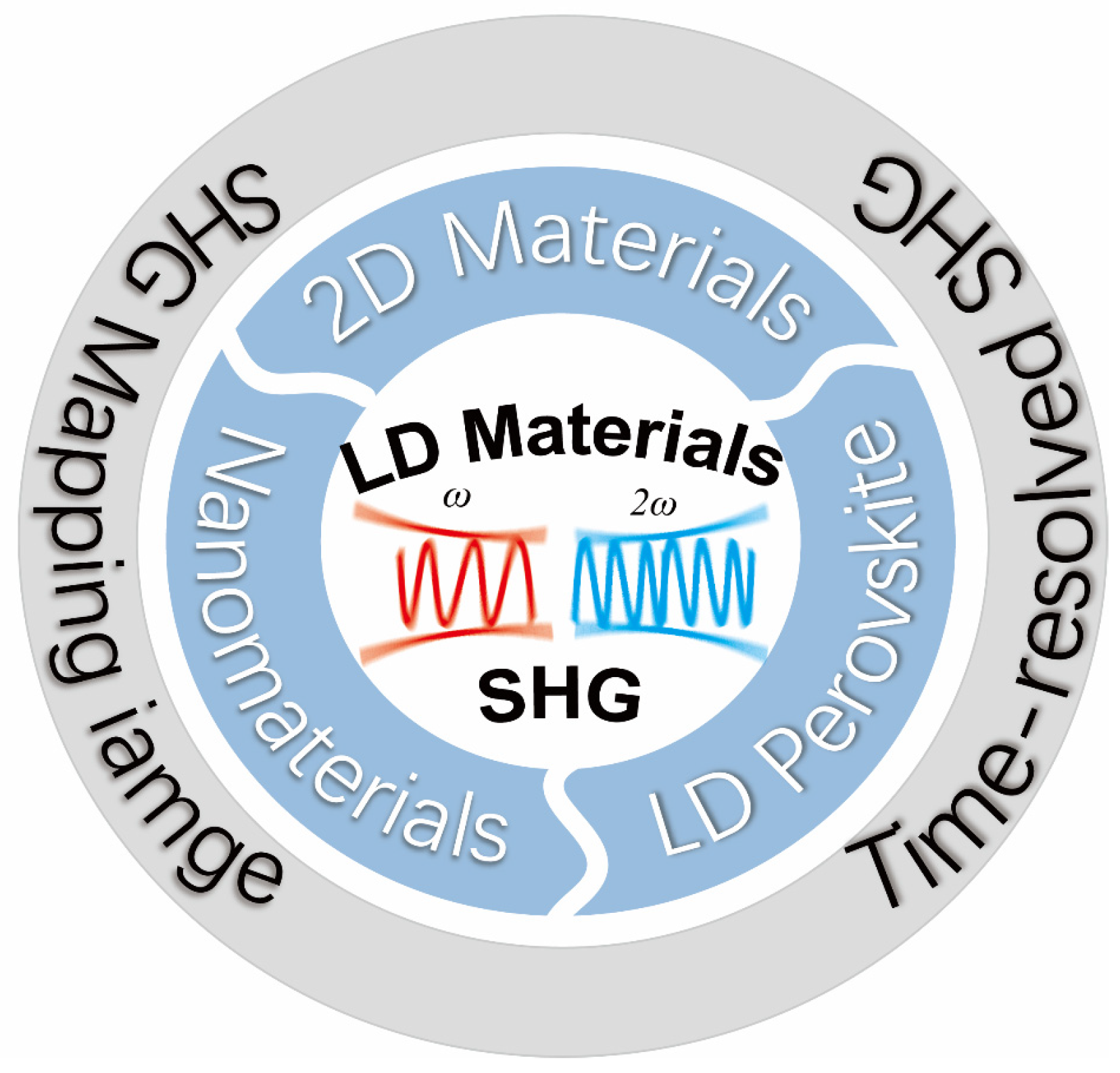

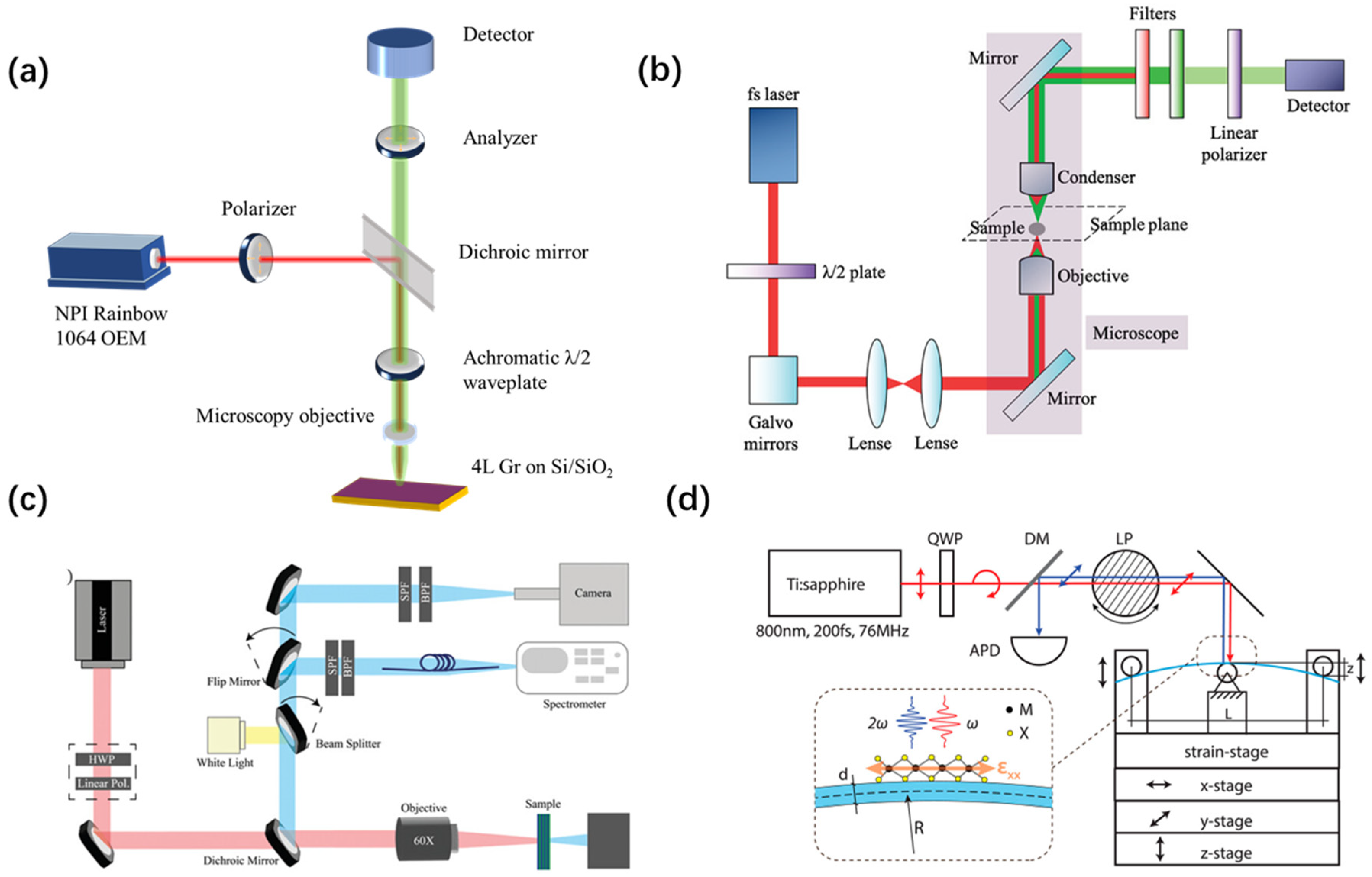
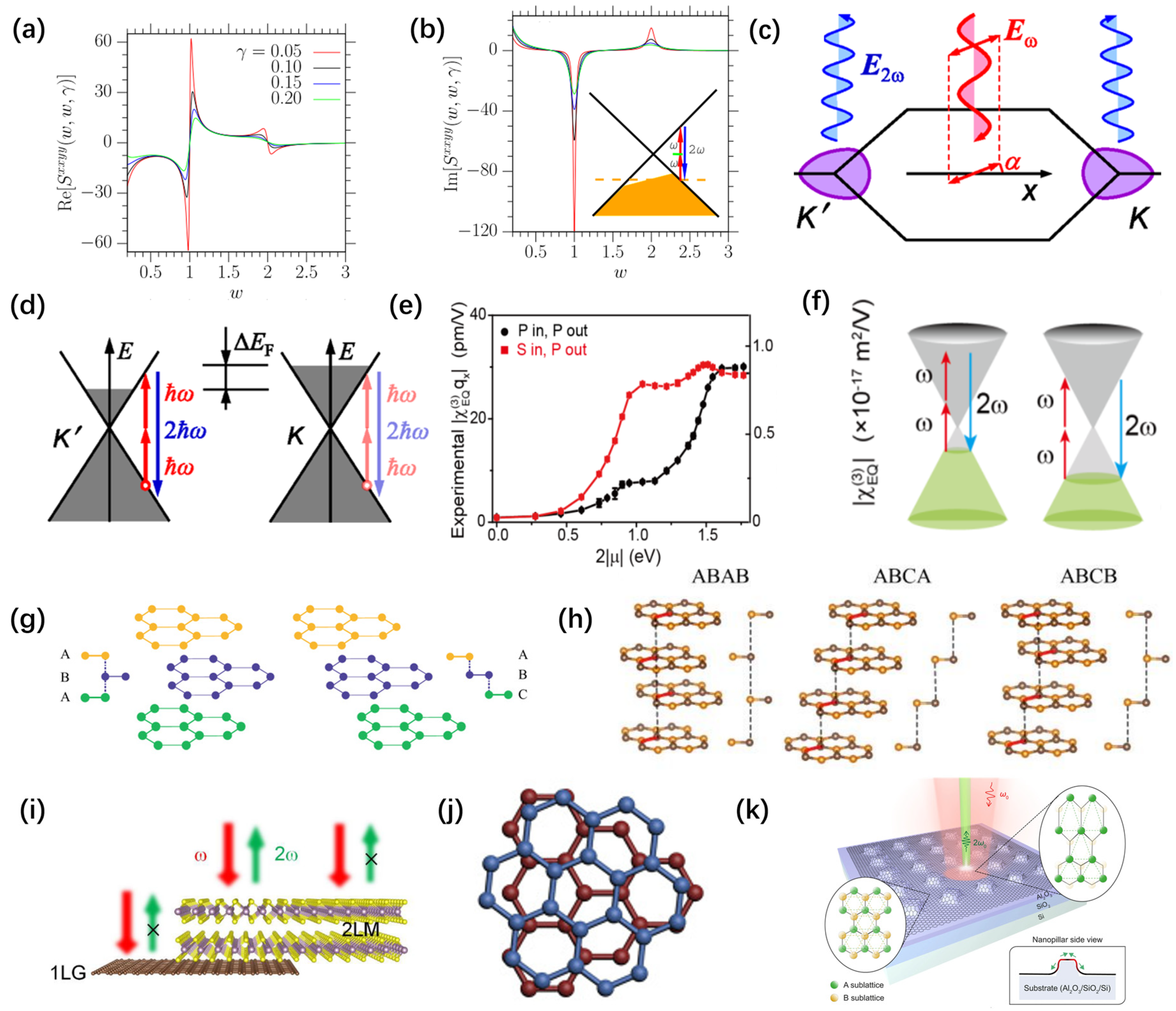
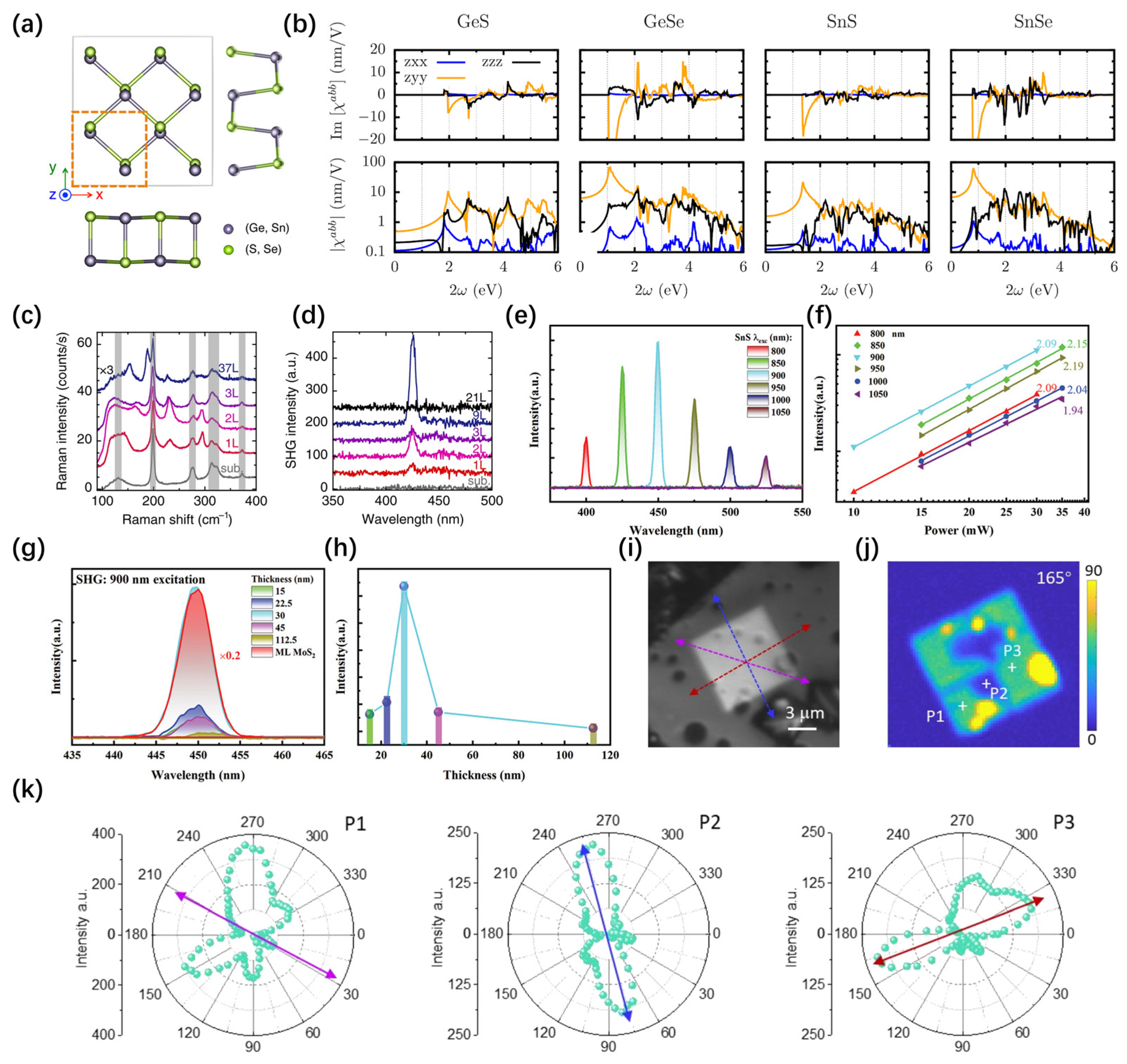
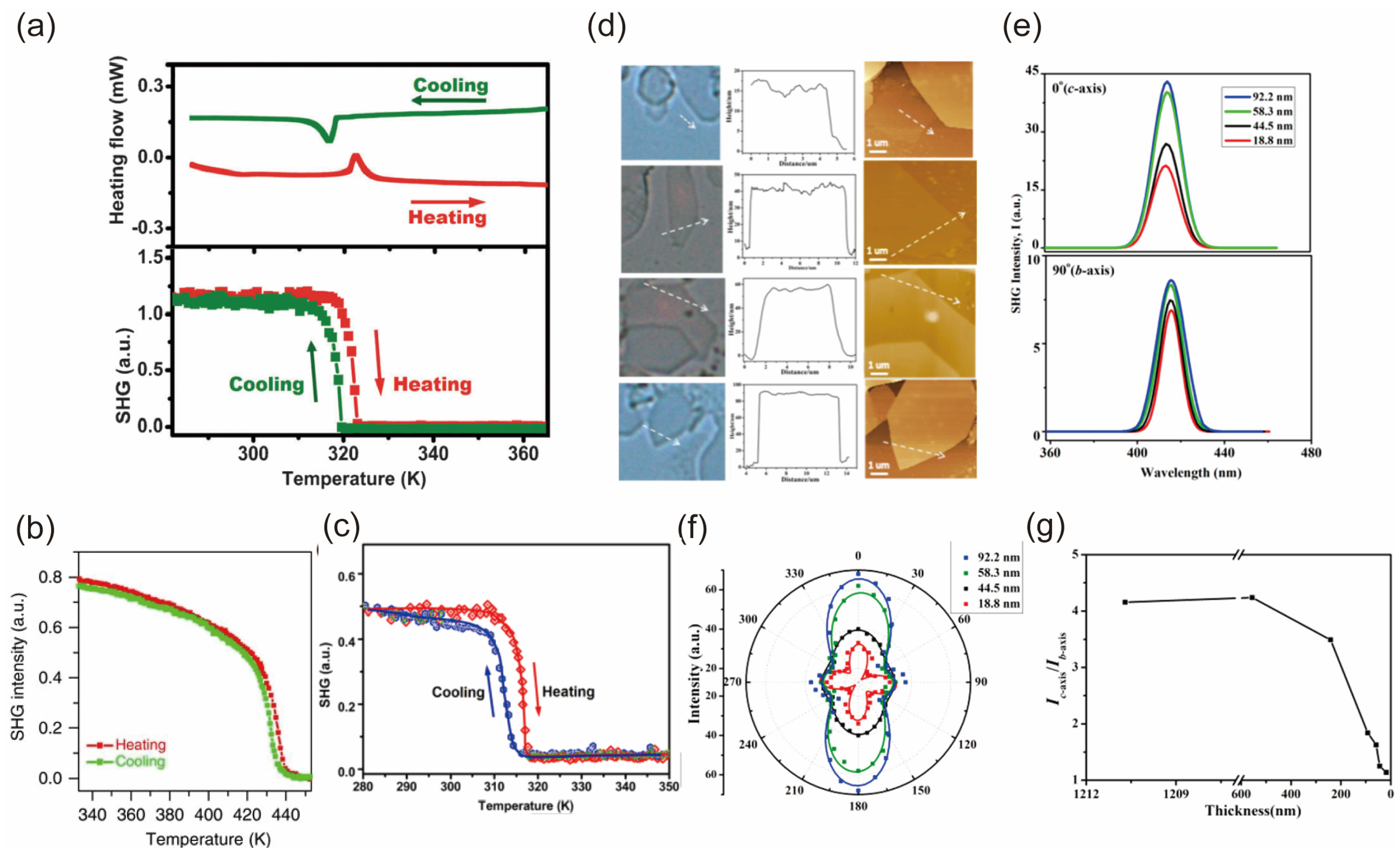

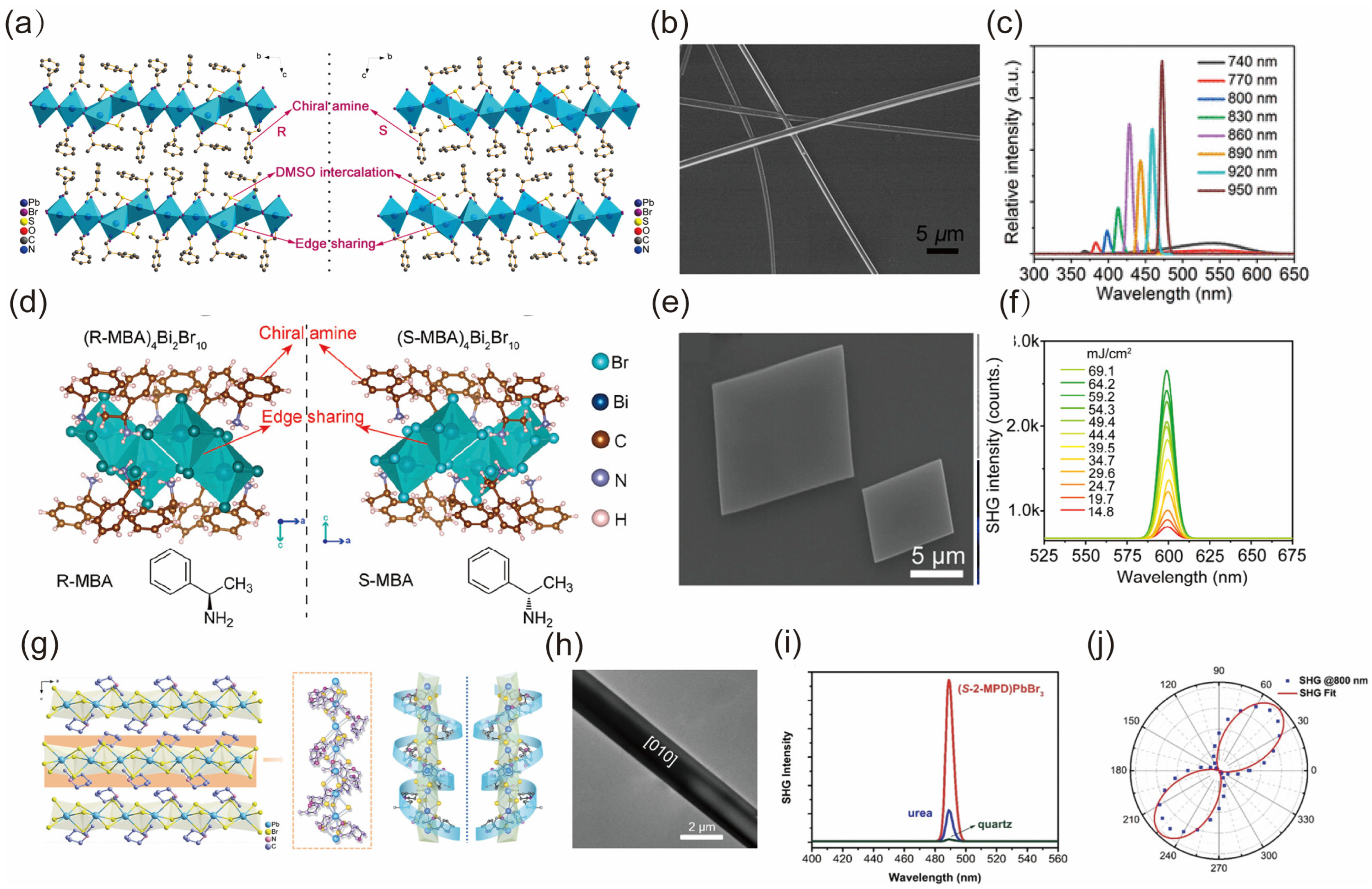
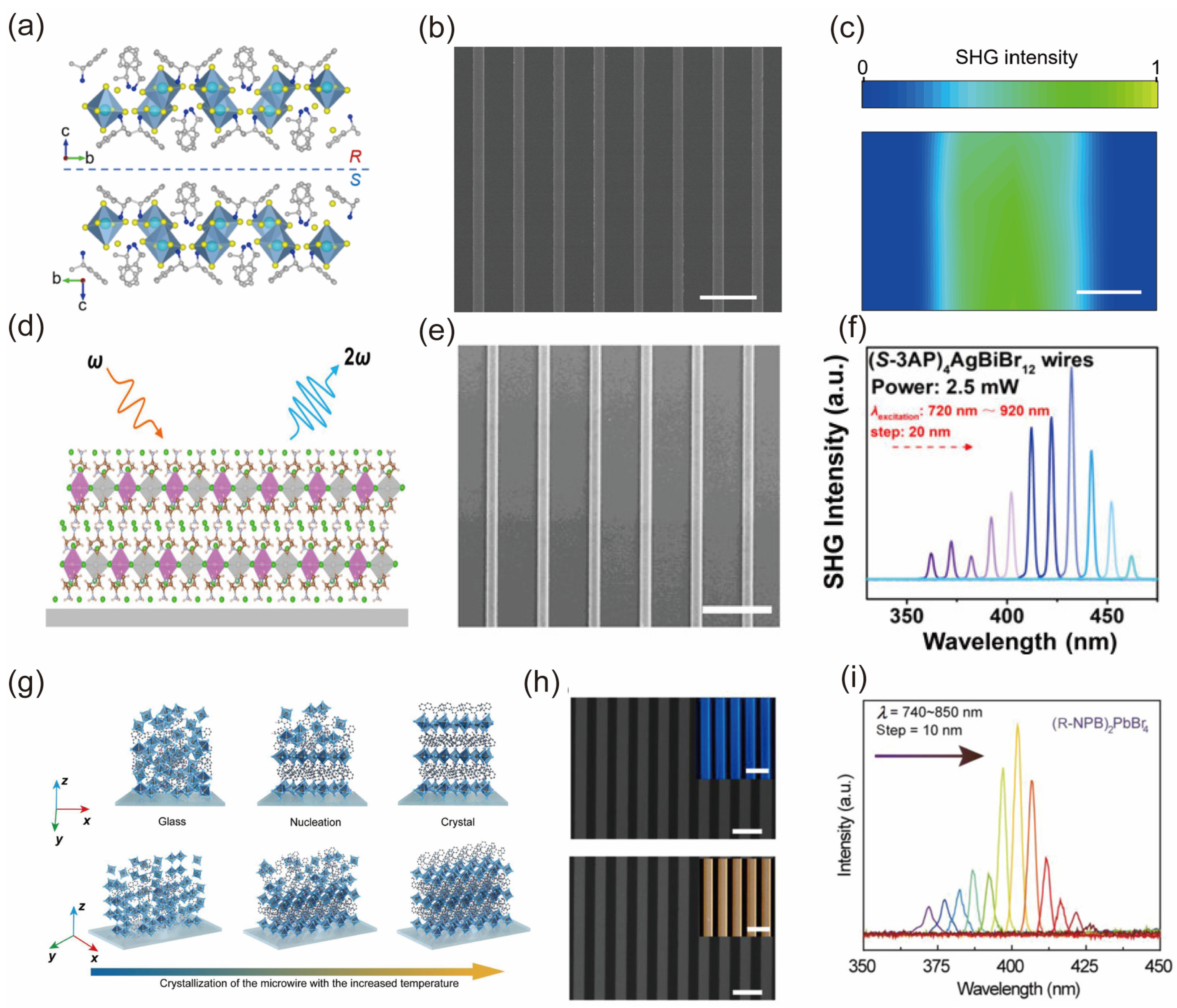
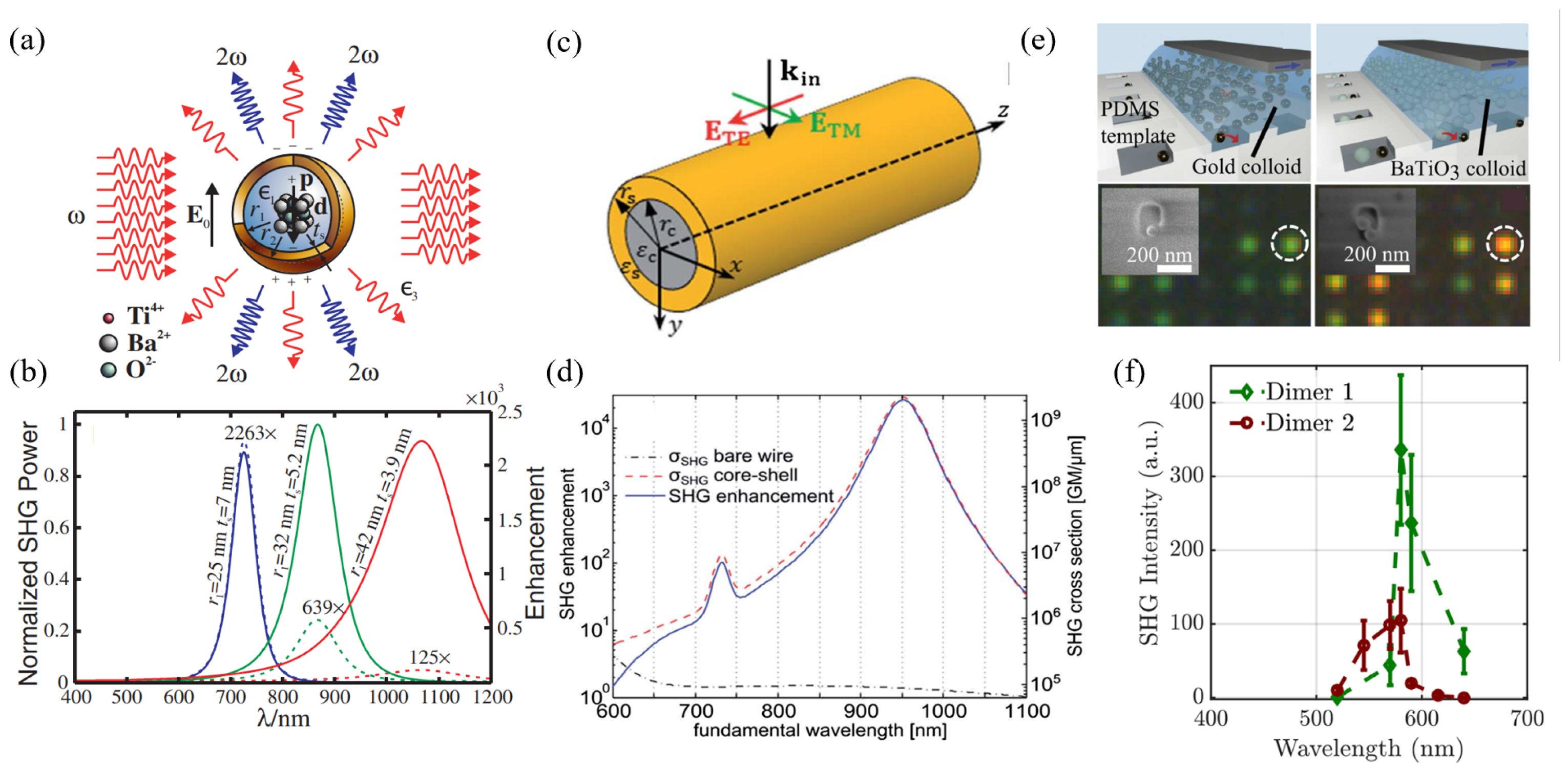
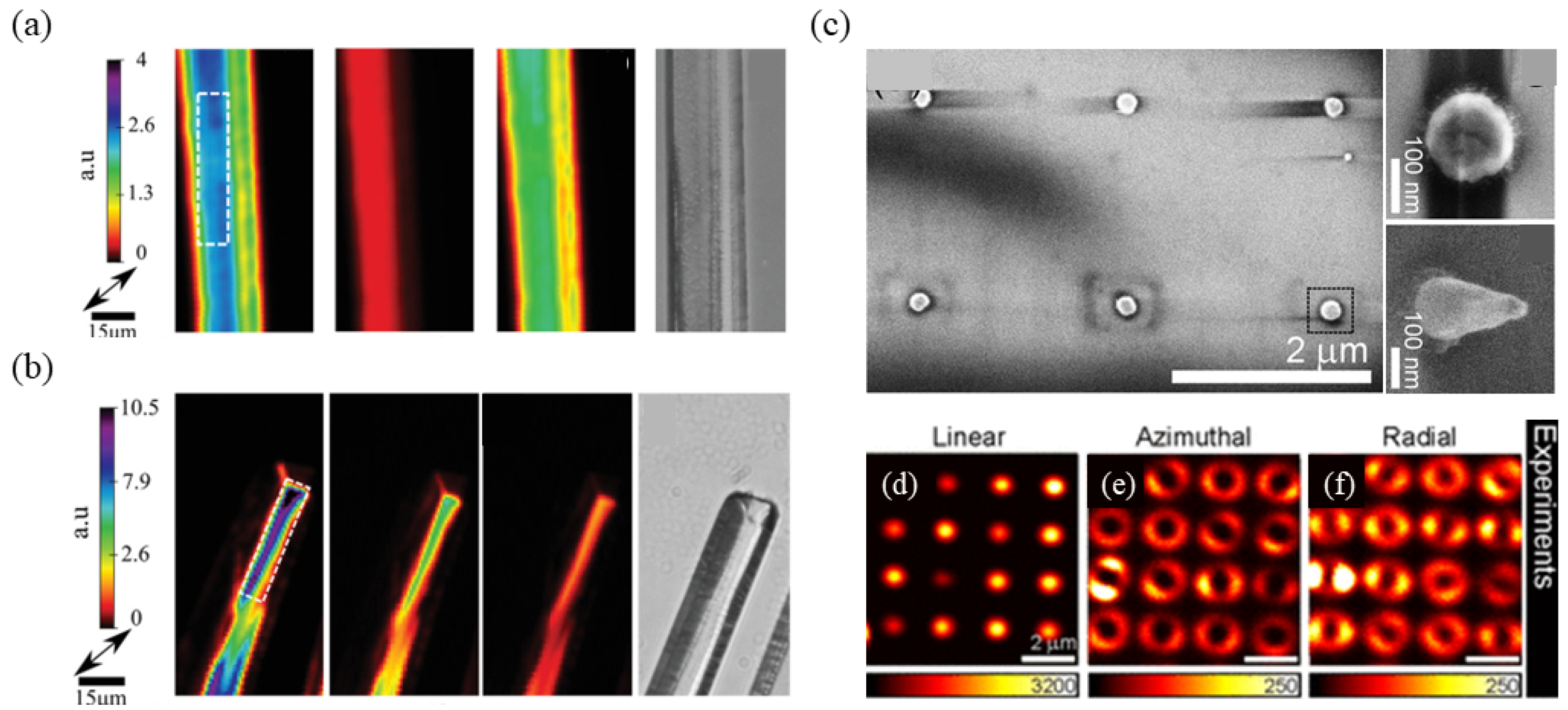

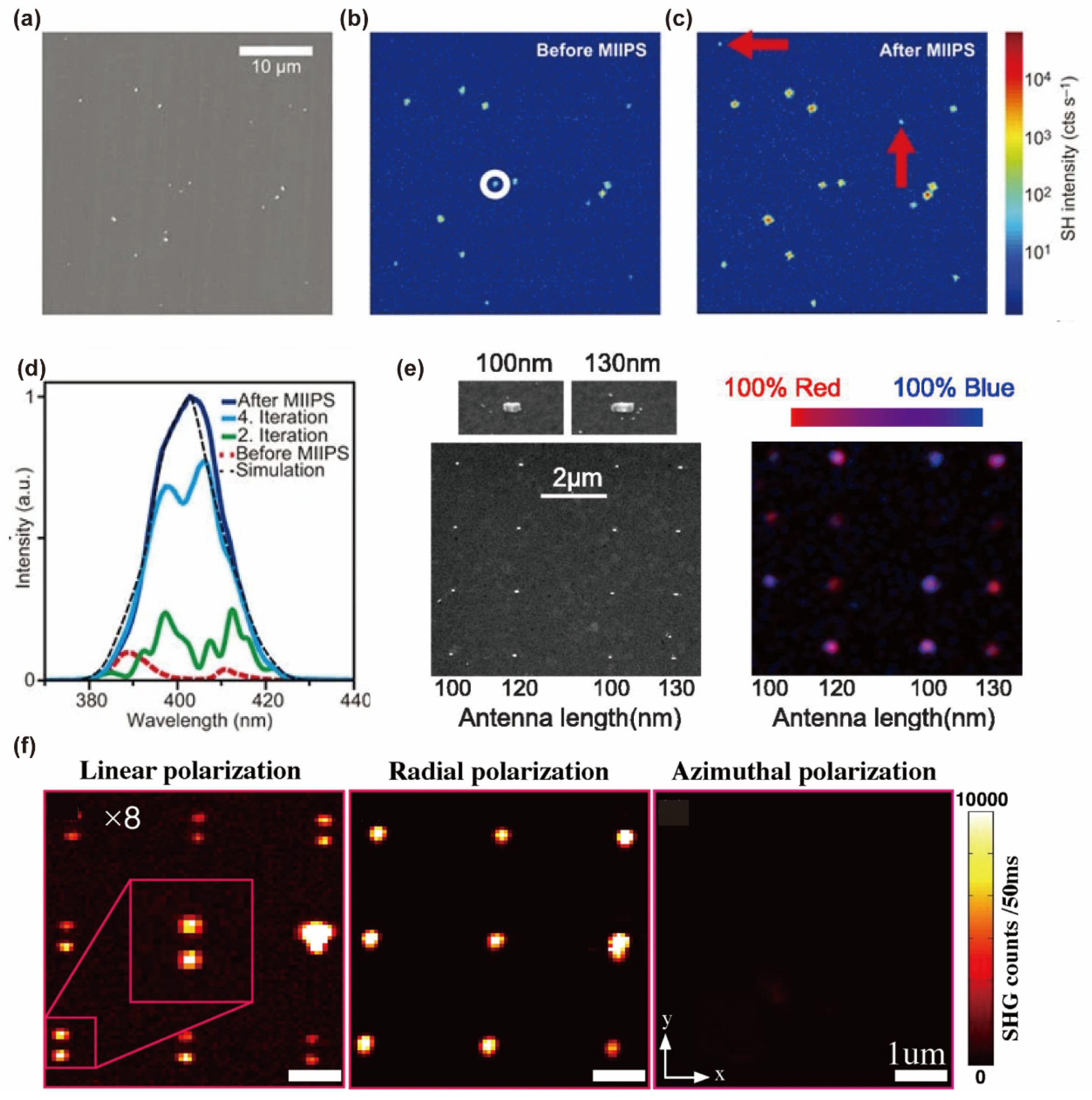
| Material | SHG Phenomena | Emission Wavelength (nm) | Material Characteristics | Substrate | Ref. | ||
|---|---|---|---|---|---|---|---|
| Fabrication Method | Thickness of Sample Investigated | ||||||
| Graphene | Current induced | 120 | 3100 | - | 1 L | - | [80] |
| Current induced | 200 | 370 | Thermal annealing | 4 L | SiC | [81] | |
| Doping | 22 | 653 | CVD | 1 L | Fused Silica | [79] | |
| Doping | - | - | CVD | 2 L | SiO2/Si | [82] | |
| Stacking induced | 90 | 650 | Exfoliation | 3 L (ABA) | SiO2/Si | [83] | |
| Stacking induced | - | 532 | Exfoliation | 4 L (ABAB) | SiO2/Si | [54] | |
| Twisting | 424 | 532 | Exfoliation | 2 L | SiO2/Si | [84] | |
| non-uniformly straining | - | 517.5 | Exfoliation | 1 L | Al2O3 | [55] | |
| Material | Emission Wavelength (nm) | Material Characteristics | Substrate | Ref. | ||
|---|---|---|---|---|---|---|
| Fabrication Method | Thickness of Sample Investigated | |||||
| MoS2 | 120 | 435 | Exfoliation | 1 L | Quartz | [101] |
| 29.5 | 440 | Exfoliation | 3 L | Quartz | [101] | |
| ~105 | 405 | Exfoliation | 1 L | SiO2/Si | [34] | |
| ~5000 | 405 | CVD | 1 L | SiO2/Si | [34] | |
| 430 | 580 | CVD | 1 L | SiO2/Si | [102] | |
| 2 | 780 | CVD | 1 L | SiO2/Si | [103] | |
| WS2 | 4500 | 415 | Exfoliation | 1 L | SiO2/Si | [41] |
| 500 | 440 | CVD | 1 L | SiO2/Si | [104] | |
| 460 | 532 | Exfoliation | 1 L | Quartz | [105] | |
| MoSe2 | 50 | 810 | CVD | 1 L | SiO2/Si | [106] |
| 7800 | 775 | Exfoliation | 1 L | Si waveguide | [107] | |
| WSe2 | 100 | 775 | Exfoliation | 1 L | SiO2/Si | [108] |
| 19 | 775 | Exfoliation | 5 L | SiO2/Si | [108] | |
| 1000 | ~443 | Exfoliation | 1 L | SiO2/Si | [59] | |
| MoTe2 | 2500 | 775 | Exfoliation | 1 L | SiO2/Si | [109] |
| Material | (Emission Wavelength) | Material Characteristics | Substrate | Ref. | ||
|---|---|---|---|---|---|---|
| Experimental | Simulation | Fabrication Method | Thickness of Sample Investigated | |||
| GeSe | 7368 (939 nm) | - | 1 L | - | [129] | |
| 500–10,000 (620–1550 nm) | - | 1 L | - | [130] | ||
| GeS | 200–8000 (443–1550 nm) | - | 1 L | - | [130] | |
| SnSe | 200–10,000 (620–1550 nm) | - | 1 L | - | [130] | |
| SnS | 550–7800 (550–1550 nm) | - | 1 L | - | [130] | |
| 1.37 (450 nm) | MBE | ~30 nm | MgO | [57] | ||
| Material | Emission Wavelength (nm) | Material Characteristics | Substrate | Ref. | ||
|---|---|---|---|---|---|---|
| Fabrication Method | Thickness of Sample Investigated | |||||
| GaSe | 2400 | 605 | CVD | 1 L | Fused silica | [143] |
| 1700 | 675 | CVD | 1 L | Fused silica | [143] | |
| 700 | 800 | CVD | 1 L | Fused silica | [143] | |
| 30 | 400 | Exfoliation | 2 L | SiO2/Si | [144] | |
| 18 | 780 | Exfoliation | Bulk | Si | [145] | |
| GaS | 47.98 | 440 | Exfoliation | 3 L | Quartz | [146] |
| GaTe | 1.15 | 780 | Exfoliation | 14 nm | SiO2/Si | [147] |
| InSe | 639 | 400 | PVD | 1 L | SiO2/Si | [148] |
| 13 | 400 | Exfoliation | Bulk | SiO2/Si | [133] | |
Disclaimer/Publisher’s Note: The statements, opinions and data contained in all publications are solely those of the individual author(s) and contributor(s) and not of MDPI and/or the editor(s). MDPI and/or the editor(s) disclaim responsibility for any injury to people or property resulting from any ideas, methods, instructions or products referred to in the content. |
© 2024 by the authors. Licensee MDPI, Basel, Switzerland. This article is an open access article distributed under the terms and conditions of the Creative Commons Attribution (CC BY) license (https://creativecommons.org/licenses/by/4.0/).
Share and Cite
Fu, Y.; Liu, Z.; Yue, S.; Zhang, K.; Wang, R.; Zhang, Z. Optical Second Harmonic Generation of Low-Dimensional Semiconductor Materials. Nanomaterials 2024, 14, 662. https://doi.org/10.3390/nano14080662
Fu Y, Liu Z, Yue S, Zhang K, Wang R, Zhang Z. Optical Second Harmonic Generation of Low-Dimensional Semiconductor Materials. Nanomaterials. 2024; 14(8):662. https://doi.org/10.3390/nano14080662
Chicago/Turabian StyleFu, Yue, Zhengyan Liu, Song Yue, Kunpeng Zhang, Ran Wang, and Zichen Zhang. 2024. "Optical Second Harmonic Generation of Low-Dimensional Semiconductor Materials" Nanomaterials 14, no. 8: 662. https://doi.org/10.3390/nano14080662
APA StyleFu, Y., Liu, Z., Yue, S., Zhang, K., Wang, R., & Zhang, Z. (2024). Optical Second Harmonic Generation of Low-Dimensional Semiconductor Materials. Nanomaterials, 14(8), 662. https://doi.org/10.3390/nano14080662






